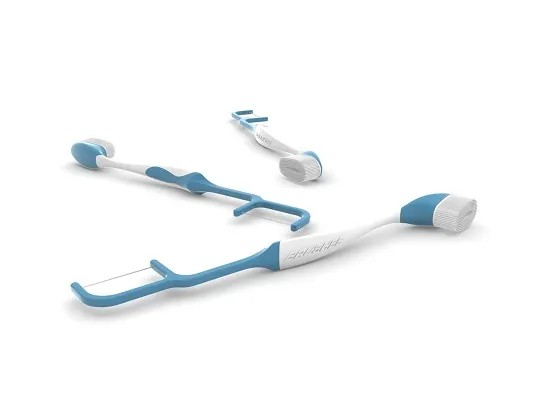What is the normal shade of teeth?
The normal shade or color of teeth can vary from person to person, and a number of factors, including genetics and diet, influence it. Generally, the normal shade of teeth is considered to be within the range of light greyish-yellow to light yellow-brown.
How does the anatomy of a tooth determine its color?
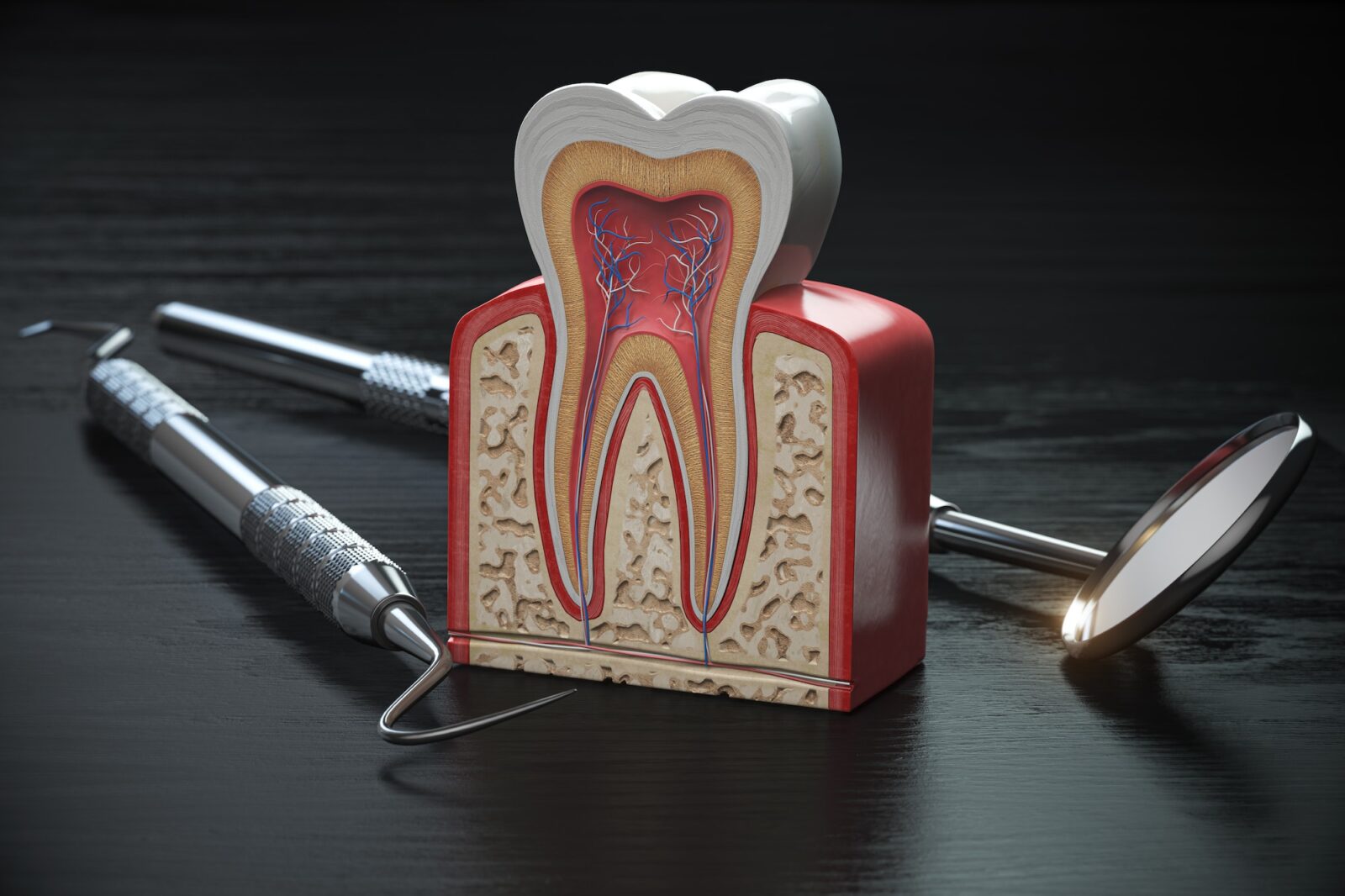
The anatomy of a tooth determines its color in several ways. The outermost layer of the tooth is called the enamel, and it is the hardest and most mineralized substance in the body. The enamel protects the tooth and gives it its characteristic white color.
Underneath the enamel is the dentin, which is a harder substance than bone, but not as hard as enamel. The dentin makes up most of the tooth and is responsible for its shape and strength. It is naturally yellow in color, but it is usually not visible because it is covered by enamel.
The pulp, which is the innermost layer of the tooth, contains the blood vessels, nerves, and connective tissue that nourishes the tooth. The pulp is not visible, as the dentin and the enamel surround it.
A combination of the color of the enamel and the underlying dentin determines the shade or color of a tooth. The shade of the enamel is influenced by genetics, while the color of the dentin is determined by the number of blood vessels and other pigments it contains.
How do dentists measure the shade of a tooth?

Dentists use a dental shade guide to measure the shade of a tooth. A dental shade guide is a tool that consists of a series of labeled teeth-shaped tabs, each of which is a different shade. The shade guides are usually made of plastic or porcelain and are designed to mimic the natural shades of teeth.
To measure the shade of a tooth, the dentist will compare the color of the tooth to the shades on the dental shade guide and choose the tab that most closely matches the tooth’s color. The shade of the tooth is then recorded on the patient’s chart, and this information can be used to determine the appropriate shade of tooth-colored restorative materials, such as fillings or crowns.
Why do different teeth have different shades?
Different teeth can have different shades for a number of reasons. One of the main factors that can affect the shade of a tooth is its location in the mouth. Front teeth, or incisors, tend to be lighter in color than back teeth, also known as molars. This is because the front teeth have a thinner layer of enamel, which allows more of the underlying dentin to show through. The dentin is naturally yellow in color, which can give the front teeth a slightly yellow or off-white appearance.
Stains and discoloration of the teeth can also cause different teeth to have different shades. These stains can be caused by various factors, including consuming certain foods and drinks, tobacco use, genetics, age, and poor oral hygiene. The type and severity of the stains can vary from tooth to tooth, which can cause the teeth to have different shades.
Do different races have different average teeth shades?

Some evidence suggests that people of East Asian descent may have slightly yellower teeth on average compared to people of European descent. This may be due to genetic differences in the structure and composition of the enamel and dentin. However, it is important to note that there is a lot of variation within each racial group.
What are the causes of teeth discoloration?
Consumption of Certain Foods and Drinks
Certain foods and drinks, such as coffee, tea, red wine, and dark-colored fruit juices, contain pigments that can stain the enamel on the teeth. These pigments are absorbed into the pores of the enamel and can cause the teeth to become discolored.
In addition to staining the enamel, some foods and drinks can also cause the teeth to become discolored by altering the pH balance in the mouth. When the pH balance in the mouth becomes too acidic, it can cause the enamel on the teeth to break down and become weakened. This can make the teeth more susceptible to staining and discoloration.
Poor Oral Hygiene

- Plaque build-up: Plaque is a thin film of bacteria that forms on the teeth and gums. If it is not removed through regular brushing and flossing, it can harden into tartar, which is a yellow or brownish substance that can be difficult to remove. Tartar build-up can cause the teeth to appear yellowed or discolored.
- Cavities: Cavities, also known as dental caries, are small holes in the teeth that are caused by the breakdown of the enamel by bacteria. Cavities can cause the teeth to appear brown or black, and they can also cause the teeth to become sensitive.
- Gum disease: Gum disease, also known as periodontal disease, is an infection of the gums that can cause the gums to become red, swollen, and bleed easily. It can also cause the gums to recede, which can expose the roots of the teeth and cause the teeth to appear yellowed or discolored.
Trauma
- Exposure of the dentin: If the trauma causes the enamel on the tooth to crack or chip, it can expose the dentin underneath. The dentin is yellow in color, and if it is exposed, it can cause the tooth to appear yellowed or discolored.
- Bruising: A blow to the mouth or face can cause the teeth to become bruised, which can cause them to appear black or blue.
- Pulp damage: If the pulp, which is the innermost layer of the tooth, is damaged due to trauma, it can cause the tooth to become discolored. This is because the pulp contains the blood vessels, nerves, and connective tissue that nourish the tooth, and if it is damaged, it can cause the tooth to die.
It is important to note that the severity and type of discoloration caused by trauma to the teeth can vary depending on the type and extent of the injury. Seeking prompt medical attention can help to minimize the risk of permanent damage to the teeth.
Aging
As we age, the enamel on our teeth can become thinner and more transparent, allowing more of the underlying dentin to show through. This can cause the teeth to appear yellowed or discolored.
Tobacco Use
- Staining: Tobacco products, such as cigarettes and chewing tobacco, contain substances that can stain the teeth. These substances can be absorbed into the pores of the enamel and cause the teeth to become yellowed or discolored.
- Plaque and tartar build-up: Tobacco use can contribute to the build-up of plaque and tartar on the teeth, which can cause the teeth to appear yellowed or discolored.
- Increased risk of gum disease: Tobacco use increases the risk of gum disease, which can cause the gums to recede, exposing the roots of the teeth and causing the teeth to appear yellowed or discolored.
- Decreased saliva production: Tobacco use can decrease saliva production in the mouth, which can cause the teeth to become dry and more prone to staining and discoloration.
You can help prevent teeth discoloration and improve oral health by quitting tobacco use. If you are struggling to quit tobacco use, it is important to seek help from a medical professional or a support group.
Restorations
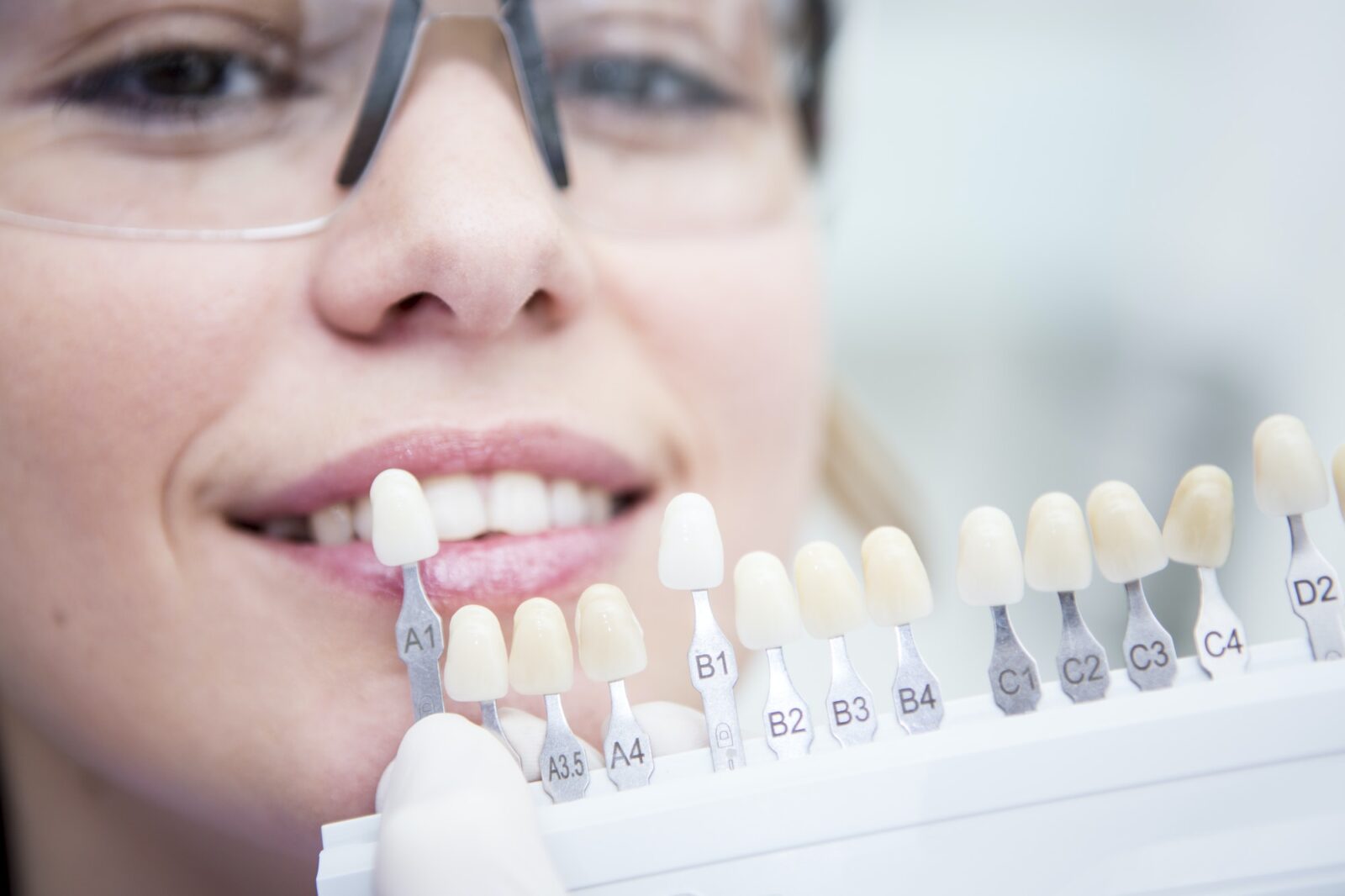
Restorations, such as fillings, crowns, and veneers, can lead to teeth discoloration in a few different ways:
- Poor color match: If the color of the restoration does not match the natural color of the surrounding teeth, it can cause the tooth to appear discolored.
- Staining: Restorations can become stained by certain foods and drinks, such as coffee and tea, which can cause the tooth to appear discolored.
- Wear and tear: Over time, restorations can wear down or become chipped, exposing the underlying tooth structure and causing the tooth to appear discolored.
- Leakage: If the restoration is not properly sealed, bacteria and other substances can leak under the restoration and cause the tooth to become discolored.
Not all restorations will cause teeth discoloration, and the likelihood of discoloration will depend on the restoration type used, the restoration’s quality, and the patient’s oral hygiene habits. It is always best to consult a dental professional to determine the best restoration option for your needs.
Aggressive Whitening Methods

Aggressive whitening methods, such as scrubbing or brushing the teeth with abrasive materials, can cause teeth discoloration in several ways:
- Damage to the enamel: Scrubbing or brushing the teeth with abrasive materials can remove the outer layer of the enamel, which can cause the enamel to become weakened and more prone to staining and discoloration.
- Uneven results: Scrubbing or brushing the teeth with abrasive materials may not produce a uniform color change, and the teeth may become unevenly discolored as a result.
Overexposure to Fluoride
- Dental fluorosis: Dental fluorosis is a condition that occurs when the teeth are overexposed to fluoride during the time when they are forming in the gums. It can cause the teeth to become discolored, with white or brownish-colored lines or spots appearing on the surface of the teeth. The severity of the discoloration can range from mild to severe, depending on the amount of fluoride exposure.
- Fluoride stains: Overexposure to fluoride after teeth are formed can also cause the teeth to become yellowed or browned. This is because fluoride can react with the minerals in the teeth and cause the teeth to become discolored.
Overexposure to fluoride can occur due to consuming excessive amounts of fluoride or using fluoride products that are inappropriate for your age or needs. To minimize the risk of overexposure, you must follow your dental professional’s recommendations and use fluoride products as directed.
It is important to note that while dental fluorosis and fluoride stains are not harmful to the teeth, they can affect the appearance of the teeth and may require treatment to be removed or lightened. It is always best to consult a dental professional for a proper evaluation and treatment plan.
Medical Conditions
Certain medical conditions can cause teeth discoloration in several ways:
- Metabolic disorders: Metabolic disorders, such as phenylketonuria (PKU), can cause the teeth to become discolored. PKU is a rare disorder that affects how the body processes the amino acid phenylalanine. If left untreated, it can cause the teeth to become yellowed or browned.
- Medications: Some medications, such as tetracycline antibiotics and certain types of chemotherapy drugs, can cause the teeth to become discolored. Tetracycline antibiotics can interfere with the proper formation of the teeth, which can cause the teeth to become yellowed or browned. Chemotherapy drugs can cause teeth to become darker in color.
Genetics
- Inherited traits: The color and appearance of the teeth can be influenced by inherited traits, such as the color of the enamel and the tooth’s shape. For example, some individuals may be born with thinner or thicker enamel, which can affect the appearance of the teeth.
- Genetic disorders: Some genetic disorders, such as amelogenesis imperfecta and dentinogenesis imperfecta, can cause the teeth to become discolored. These disorders affect the way the teeth develop and can cause the teeth to appear yellow, brown, or mottled in color.
What are some ways to prevent teeth discoloration?
Practice Good Oral Hygiene
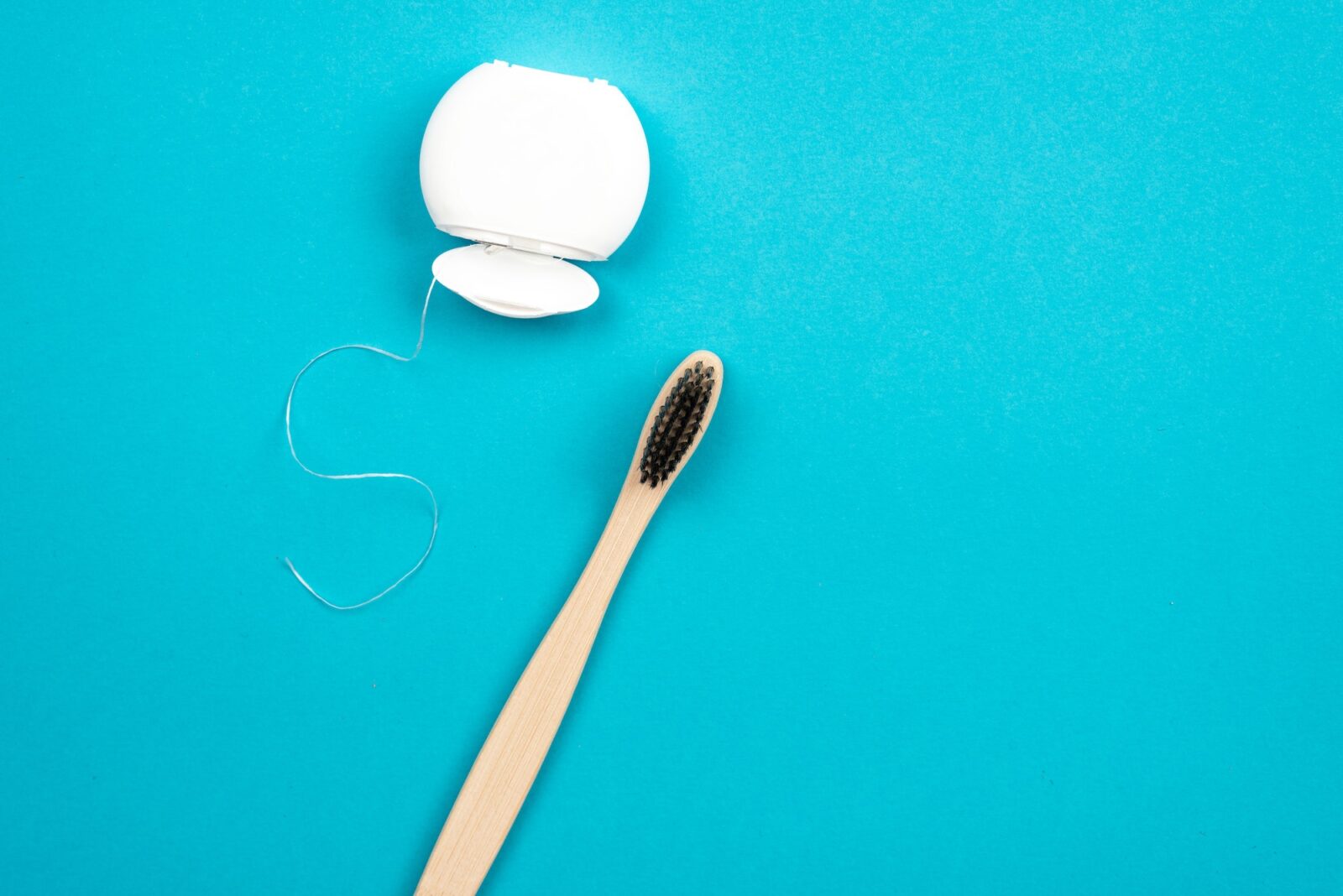
Good oral hygiene, including brushing and flossing regularly and using fluoride toothpaste, can help to prevent staining and discoloration of the teeth and may reduce the need for teeth whitening.
Minimize the Consumption of Staining Substances
Certain foods and drinks, such as coffee, tea, red wine, and tobacco, can stain the teeth and may increase the need for teeth whitening. It is generally recommended to avoid or minimize the consumption of these substances to help prevent staining and discoloration of the teeth.
Use Mouthwash
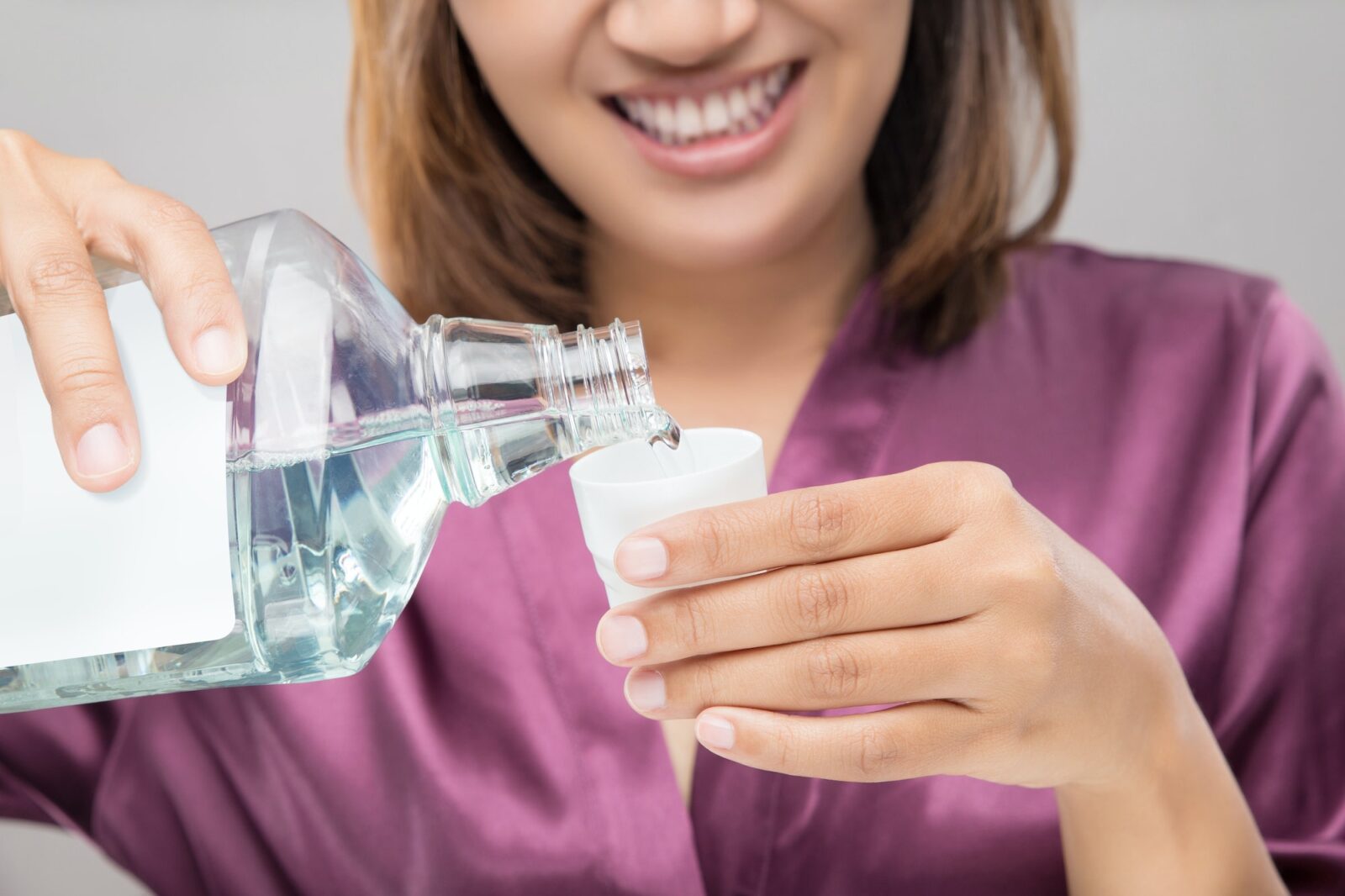
Using a mouthwash containing fluoride can help protect the teeth from staining and may reduce the need for teeth whitening.
Drink Water
Drinking water can help rinse food particles and other substances that can stain the teeth and may reduce the need for teeth whitening.
Visit the Dentist Regularly
Visiting the dentist regularly for cleanings and checkups can help to remove surface stains and keep the teeth healthy, which may reduce the need for teeth whitening.
Are stains on teeth permanent?
Stains on teeth are generally not permanent and can be removed or lightened through professional cleaning or tooth whitening treatments.
There are two types of teeth stains: extrinsic and intrinsic.
What are extrinsic stains?
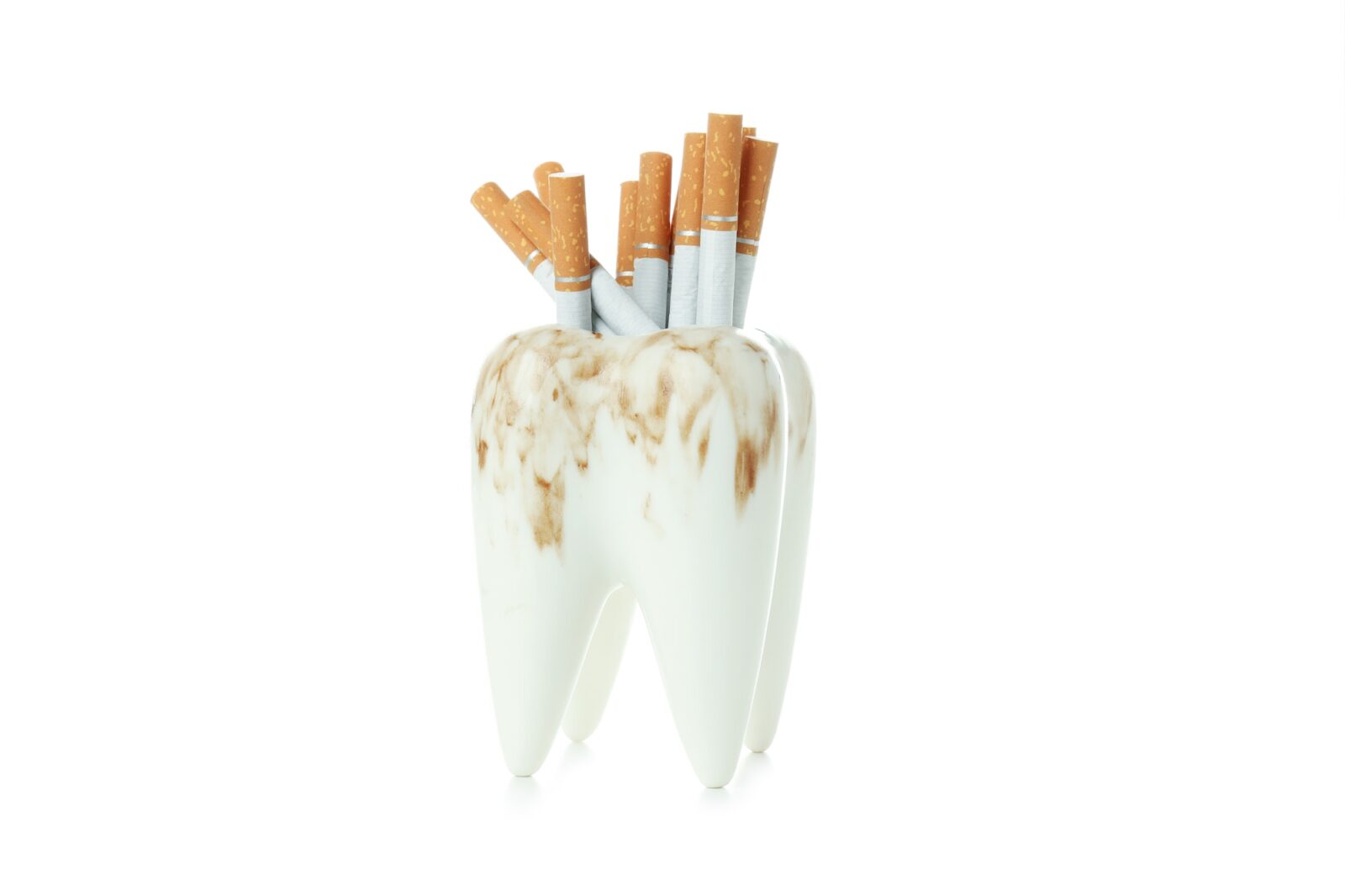
Definition
Extrinsic stains occur on the surface of the tooth, as opposed to inside the tooth. Things like food and drinks, tobacco use, and poor oral hygiene typically cause them. Extrinsic stains can often be removed with regular teeth cleaning and whitening treatments.
Causes
- Food and drinks: Consuming certain foods and drinks, such as coffee, tea, and red wine, can cause extrinsic stains on the teeth.
- Tobacco use: Smoking or using tobacco products can cause extrinsic stains on the teeth.
- Poor oral hygiene: Failing to brush and floss regularly can allow bacteria and plaque to build up on the teeth, leading to extrinsic stains.
Treatments
- Professional teeth cleaning: Professional teeth cleaning, also known as dental prophylaxis, can remove plaque and tartar from the teeth and improve the overall appearance of the teeth.
- Whitening toothpaste: Some toothpaste brands claim to have teeth-whitening properties and can be used to remove stains and improve the overall appearance of the teeth.
- Whitening mouthwash: Some mouthwash brands claim to have teeth-whitening properties and can be used to remove stains and improve the overall appearance of the teeth.
- Whitening trays: Whitening trays are custom-fit trays that are filled with a whitening gel and worn over the teeth. They can be used for both in-office and at-home whitening procedures.
- Whitening pens: Whitening pens are small, portable pens that contain a whitening gel and can be used to touch up specific areas of the teeth.
- Whitening strips: Whitening strips are thin, flexible strips that are coated with a whitening gel and worn over the teeth. They can be used for both in-office and at-home whitening procedures.
What are intrinsic stains?

Definition
Intrinsic stains occur inside the tooth, as opposed to on the surface of the tooth. They are typically caused by things like medications, injuries to the tooth, or conditions that affect the development of the tooth. Intrinsic stains can be more difficult to remove than surface stains, requiring more intensive whitening treatments.
Causes
- Medications: Certain medications, such as tetracycline antibiotics, can cause intrinsic stains and discoloration of the teeth. Tetracycline stains are usually yellow, brown, or gray and may be more noticeable in individuals with lighter-colored teeth.
- Fluorosis: Fluorosis is a condition that occurs when the teeth are exposed to excessive amounts of fluoride during tooth development. This can cause the teeth to become discolored, with white or brown mottling or spotting. Fluorosis is more common in areas with high levels of naturally occurring fluoride in the water or in individuals who consume large amounts of fluoride supplements.
- Injuries to the tooth: Trauma or injury to the tooth can cause the tooth to develop intrinsic stains. These stains may be caused by bleeding or other damage to the tooth.
- Conditions that affect tooth development: Certain medical conditions, such as fetal alcohol syndrome or hypoplasia, can cause intrinsic stains on the teeth.
Treatments
- In-office bleaching: In-office bleaching involves the use of a high-concentration bleaching agent, such as hydrogen peroxide or carbamide peroxide, applied to the teeth by a dental professional. The bleaching agent is typically activated using a special light or laser to enhance the whitening process. In-office bleaching can produce dramatic results in a single treatment, but it may be more expensive than other methods of intrinsic whitening.
- At-home bleaching: At-home bleaching involves using a lower-concentration bleaching agent, such as carbamide peroxide, applied to the teeth at home using a custom-made tray or strips. At-home bleaching may take longer to produce results than in-office bleaching, but it is generally less expensive and more convenient for individuals with busy schedules.
- Microabrasion: Microabrasion involves the use of a special abrasive paste or gel applied to the teeth to mechanically remove surface stains and discoloration. Microabrasion may be combined with bleaching agents to enhance the whitening effect.
- Bonding: Bonding involves the application of a composite resin material to the surface of the tooth to cover up stains and discoloration. Bonding can be used to improve the appearance of a single tooth or multiple teeth and can be a more affordable option than veneers.
- Veneers: Veneers are thin, custom-made shells bonded to the front surface of the teeth to cover up stains and discoloration. Veneers can be made of porcelain or composite resin and can effectively treat intrinsic stains and discoloration, but they are generally more expensive than bonding.
What is the history of teeth whitening?
What is teeth whitening?
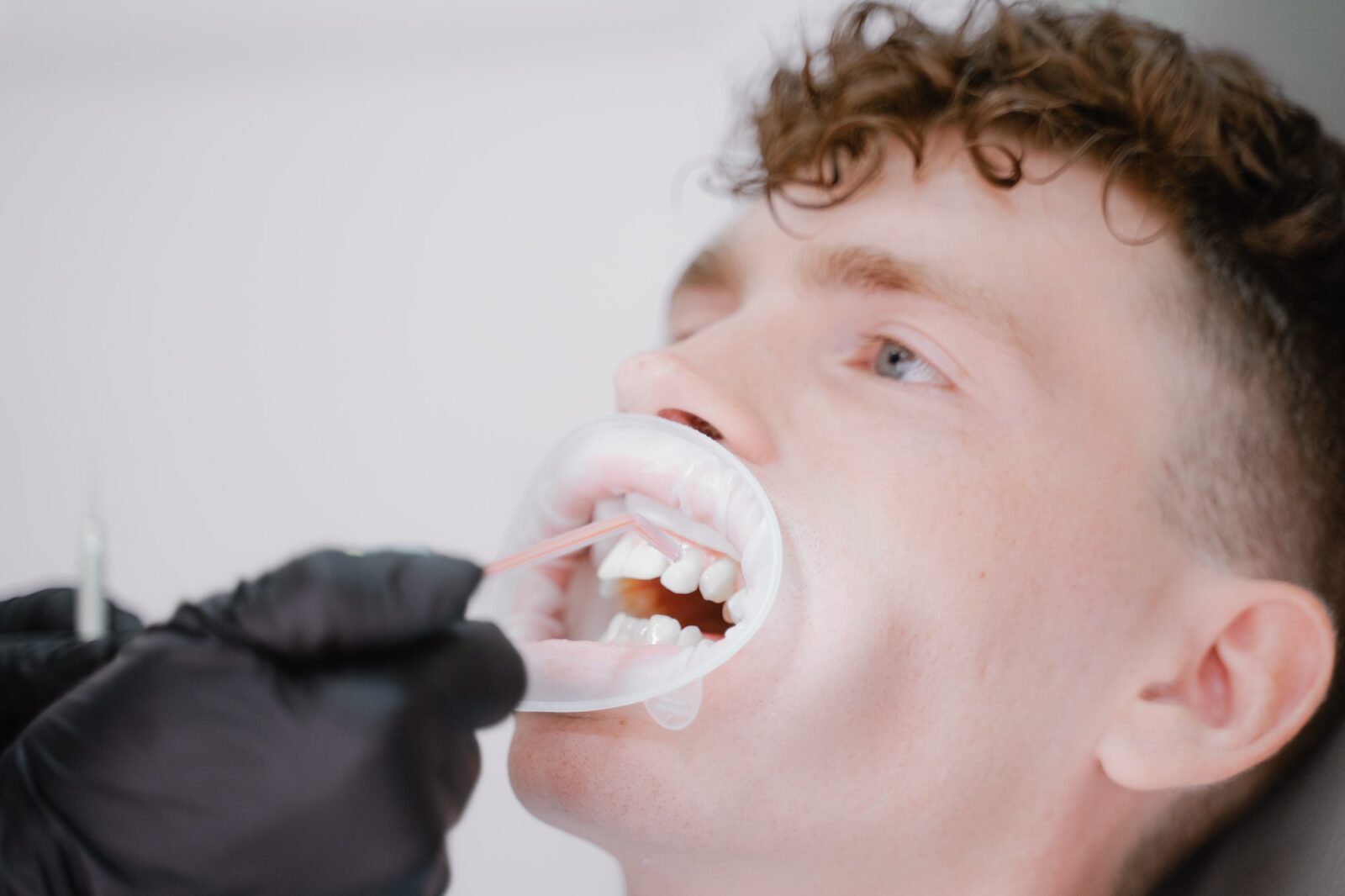
Teeth whitening is a cosmetic dental procedure that is used to lighten the color of the teeth. The goal of teeth whitening is to improve the appearance of the teeth by removing stains and discoloration and giving the teeth a brighter, more youthful look.
There are several different methods of teeth whitening available, including:
- Oral hygiene: Good oral hygiene practices such as regular brushing, flossing, and dental check-ups are essential for maintaining a healthy and white smile. Keeping your teeth and gums clean can help prevent surface stains and discoloration caused by plaque and tartar buildup.
- Home remedies: Some people use home remedies such as baking soda or charcoal to whiten their teeth. These methods can be effective in removing surface stains, but they may not be as effective as professional treatments and can cause tooth sensitivity if used incorrectly.
- Over-the-counter products: There are many over-the-counter products such as whitening toothpastes, gels, and strips that can be purchased at a drugstore. These products can be less effective than other methods and may cause tooth sensitivity.
- Take-home kits: At-home whitening kits include custom-made trays that fit over the teeth and a bleaching gel. The trays are worn for a set period of time, usually at night, and the gel is used to whiten the teeth over time. This method is less expensive than in-office whitening and can be done in the comfort of your own home.
- In-office professional treatments: In-office whitening is a professional teeth whitening treatment that is performed in a dental office. The dentist will apply a bleaching gel to the teeth and use a special light or laser to activate the gel and whiten the teeth. This method can provide fast and dramatic results, but it is also the most expensive and can cause tooth sensitivity.
- Whitening restorations: This method involves replacing existing dental restorations such as crowns, veneers, or fillings with new, whitened versions. This can include replacing old metal fillings with tooth-colored composite fillings or replacing old crowns or veneers with new, whitened versions. This method can be more effective in restoring a natural-looking, white smile, but it is also more expensive and may require multiple dental visits.
How did teeth whitening start?
The history of teeth whitening dates back to ancient civilizations when people used various methods to try to whiten and brighten their teeth. Some of the early methods used to whiten teeth included:
- Rubbing the teeth with ashes or crushed eggshells: In ancient Egypt and Greece, people would rub their teeth with ashes or crushed eggshells in an attempt to whiten and brighten them.
- Using pumice: In ancient Rome, people would use pumice, a type of volcanic rock, to scrub their teeth in an attempt to whiten them.
- Using a mixture of vinegar and honey: In ancient China, people would mix vinegar and honey and use the mixture to whiten their teeth.
- Using a mixture of urine and wood ash: In medieval Europe, people would mix urine and wood ash and use the mixture to whiten their teeth.
It is important to note that these early teeth whitening methods were often harsh and abrasive and could harm the teeth and gums. Today, there are safer and more effective methods of teeth whitening available, such as professional teeth whitening treatments and at-home teeth whitening kits.
What is the difference between chemical and mechanical teeth whitening?
Chemical teeth whitening and mechanical teeth whitening are two different methods of whitening teeth. Here is a brief overview of the differences between the two:
- Chemical teeth whitening: Chemical teeth whitening involves using a bleaching agent, such as hydrogen peroxide or carbamide peroxide, to remove stains and discoloration from the teeth. The bleaching agent is applied to the surface of the teeth and is left on the teeth for a certain amount of time, depending on the type of bleaching agent used and the severity of the discoloration. The bleaching agent may be activated using a special light or laser to enhance the whitening process.
- Mechanical teeth whitening: Mechanical teeth whitening involves using physical abrasives to remove stains and discoloration from the teeth. This may include using special toothpaste or mouthwashes containing abrasives, or using a dental instrument, such as a scaler or polisher, to mechanically remove surface stains from the teeth.
It is important to note that chemical teeth whitening is generally more effective at removing deep stains and discoloration than mechanical teeth whitening. However, mechanical teeth whitening may be gentler on the teeth and may be a suitable option for individuals with sensitive teeth or gums. It is always best to consult a dental professional to determine the best teeth whitening method for your needs.
What is the process of teeth whitening?
Oral Hygiene
- Brush and floss teeth regularly
- Use toothpaste with whitening agents if desired
- Visit the dentist for regular check-ups and professional cleaning
Home Remedies
- Mix baking soda or charcoal with water to create a paste
- Apply the paste to the teeth with a toothbrush or cotton swab
- Leave the paste on for several minutes before rinsing it off
- Repeat the process regularly until desired results are achieved
Over-the-Counter Products
- Purchase whitening toothpastes, gels, or strips from a drugstore
- Follow the instructions on the packaging for application and usage
- Repeat the process regularly until desired results are achieved
Take-Home Kits
- Obtain a take-home kit prescribed by a dental professional
- The kit will include custom-made trays and a bleaching gel
- Wear the tray with the gel on your teeth for the recommended time, usually overnight
- Repeat the process regularly until desired results are achieved
In-Office Professional Treatments
- Schedule an appointment with a dental professional
- The dentist will apply a bleaching gel to the teeth
- Use a special light or laser to activate the gel and whiten the teeth
- Repeat the process regularly until desired results are achieved
Whitening Restorations
- Schedule an appointment with a dental professional
- The dentist will replace existing dental restorations such as crowns, veneers, or fillings with new, whitened versions.
- The process may require multiple dental visits and can be more expensive than other whitening methods.
- The replacement restorations will be matched to the color of the surrounding teeth for a natural-looking, white smile.
What are the pros of teeth whitening?

Improved Appearance
Teeth whitening can improve the appearance of the teeth by removing stains and discoloration and giving the teeth a brighter, more youthful look. This can boost self-confidence and enhance overall facial appearance.
Non-Invasive
Teeth whitening is a non-invasive procedure that does not require cutting or altering the teeth. It is generally a safe and painless way to improve the appearance of the teeth.
Convenience
Many teeth whitening treatments can be performed quickly and easily in a dental office or at home. This can make teeth whitening a convenient option for individuals who want to improve the appearance of their teeth but do not have the time or resources for more involved cosmetic dental procedures.
Cost-Effective
Teeth whitening is generally less expensive than other cosmetic dental procedures, such as veneers or crowns. This can make it a more cost-effective option for individuals who want to improve the appearance of their teeth.
Customizable
Many teeth whitening treatments can be customized to meet the specific needs and preferences of the individual patient. For example, the bleaching agent’s strength and the treatment duration can be adjusted to achieve the desired level of whitening.
Safe
When performed by a trained dental professional or used according to the instructions provided, teeth whitening is generally safe. However, it is important to follow the instructions provided with the whitening product and to consult with a dental professional to ensure that the treatment is appropriate for you and to minimize the risk of adverse effects.
Effective
Teeth whitening is generally effective at removing stains and discoloration from the teeth and can produce noticeable results within a relatively short period of time. However, the effectiveness of the treatment can vary depending on the cause and severity of the discoloration and the type of whitening treatment used.
What are the cons of teeth whitening?

Sensitivity
Some individuals may experience sensitivity or discomfort during or after teeth whitening. This may include sensitivity to hot, cold, sweet, or acidic substances. Sensitivity is generally temporary and will resolve on its own within a few days, but it can be uncomfortable for the individual.
Ineffective for Certain Stains
Teeth whitening may not effectively remove certain types of stains, such as those caused by certain medications or fluorosis (excessive fluoride exposure during tooth development). In these cases, other cosmetic dental procedures, such as veneers or bonding, may be needed to improve the appearance of the teeth.
Risk of Uneven Whitening
In some cases, teeth whitening may result in uneven whitening, with some teeth becoming significantly lighter than others. This may be due to factors such as the severity of the discoloration and the type of whitening treatment used. Uneven whitening can be corrected with additional treatments, which may require additional time and cost.
Not a Permanent Solution
Teeth whitening is not a permanent solution, and the teeth may become discolored again over time due to factors such as the consumption of staining foods and drinks and poor oral hygiene. This means that the individual may need to undergo additional teeth whitening treatments in the future to maintain their desired level of whitening.
Limited to the Color of Natural Teeth
Teeth whitening can only lighten the natural color of the teeth, and it cannot change the color of artificial substances such as crowns, veneers, or fillings. This means that if you have any artificial dental work that is not the same color as your natural teeth, it will not be affected by teeth whitening.
Not Suitable for Everyone
Teeth whitening may not be suitable for everyone, depending on the cause and severity of the discoloration and the individual’s overall oral health. For example, individuals with tooth decay or gum disease may not be good candidates for teeth whitening until their oral health issues are addressed. Teeth whitening may also not be suitable for individuals with sensitive teeth or gums or for those who are pregnant or breastfeeding.
Possible Side Effects
While teeth whitening is generally safe when performed by a trained dental professional or used according to the instructions provided, there is a risk of side effects, such as gum irritation or chemical burns. It is important to follow the instructions provided with the whitening product and to consult with a dental professional to ensure that the treatment is appropriate for you and to minimize the risk of adverse effects.
What are the different types of teeth whitening?
| Method | Effectiveness | Speed | Longevity | Cost | Feedback |
|---|---|---|---|---|---|
| Oral Hygiene | Low | Slow | Moderate | Low | Positive |
| Home Remedies | Moderate | Slow | Short | Low | Mixed |
| Over-the-Counter Products | Low | Slow | Short | Low | Mixed |
| Take-Home Kits | High | Slow | Moderate | Moderate | Positive |
| Professional In-Office Treatments | High | Fast | Short | High | Positive |
| Whitening Restorations | High | Varies | Long | High | Positive |
Oral Hygiene

Maintaining good oral hygiene is important for keeping teeth clean, healthy, and bright. This includes brushing and flossing the teeth regularly to kill bacteria and freshen the breath.
| Method | Effectiveness | Speed | Longevity | Cost | Feedback |
|---|---|---|---|---|---|
| Brushing | Low | Slow | Moderate | Low | Positive |
| Flossing | Low | Slow | Moderate | Low | Positive |
Brushing
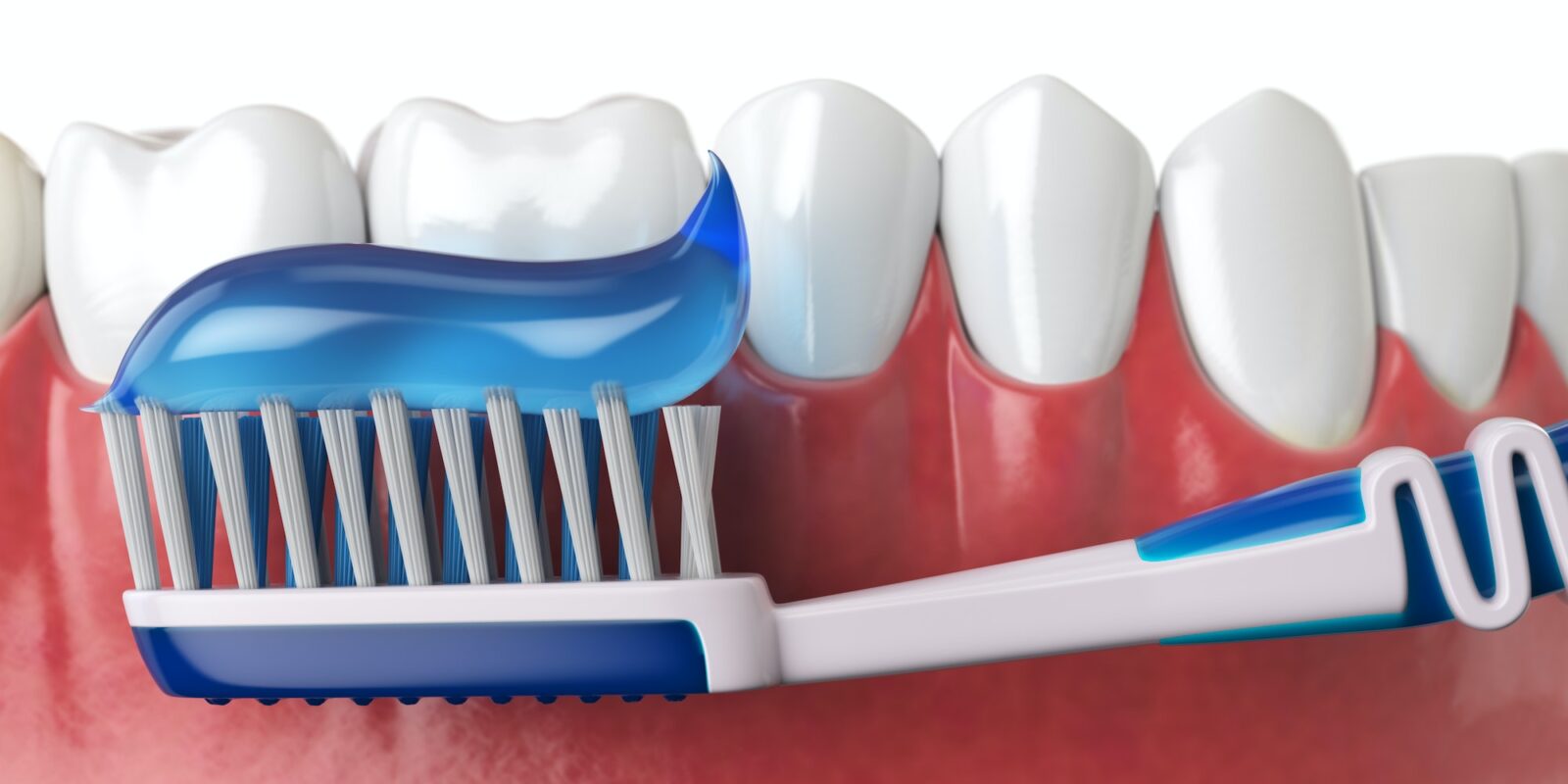
Brushing the teeth is an essential part of oral hygiene that helps to remove plaque, food particles, and bacteria from the surface of the teeth. This can help to prevent tooth decay, gum disease, and tooth discoloration, and can also help to keep the teeth looking clean and bright.
Method
To brush your teeth, you will need a toothbrush, toothpaste, and water. Wet the toothbrush and apply a small amount of toothpaste to the bristles. Hold the toothbrush at a 45-degree angle to the gums, and use a gentle circular motion to brush the fronts, backs, and tops of the teeth. Be sure to also brush the tongue to remove bacteria and freshen the breath.
Types
There are several different types of toothbrushes available, including manual and electric toothbrushes. Manual toothbrushes come in a variety of shapes, sizes, and bristle types, and can be made of nylon, rubber, or other materials. Electric toothbrushes are powered by batteries or an electrical outlet and can be more effective at removing plaque and preventing gum disease.
Brands
There are many different brands of toothbrushes available, and the best choice for you may depend on your personal preferences and needs. Some popular brands of toothbrushes include Oral-B, Crest, Colgate, and Philips Sonicare.
Candidates
Brushing the teeth is suitable for people of all ages and oral health needs. However, people with certain dental conditions, such as gum disease or sensitive teeth, may need to use a toothbrush with softer bristles or toothpaste formulated for sensitive teeth.
Results
The results of brushing the teeth may include cleaner, fresher-feeling teeth and healthier gums. Brushing can also help to remove stains from the teeth and improve the overall appearance of the smile.
Risks
Brushing the teeth is generally safe, but there is a risk of damaging the gums or teeth if the toothbrush is not used properly. It is important to be gentle when brushing and to avoid brushing too aggressively. If you experience sensitivity or discomfort while brushing, you may need to use a toothbrush with softer bristles or a toothpaste formulated for sensitive teeth.
Cost
The cost of brushing the teeth is generally low, as most types of toothbrushes and toothpaste are relatively inexpensive and can be purchased at a drugstore or online. Some types of toothbrushes, such as electric toothbrushes or toothbrushes with special features, may be more expensive, but the difference in cost is generally minimal.
Feedback
Feedback on brushing teeth is generally positive, as many people find that it helps to keep their teeth and gums clean and healthy. However, some people may find brushing to be inconvenient or uncomfortable and may be less likely to brush regularly.
Aftercare
Aftercare for brushing the teeth is relatively simple, as you will need to brush your teeth at least twice a day, once in the morning and once before bed. It is important to use toothpaste that contains fluoride to help prevent tooth decay and to use a toothbrush with soft bristles to avoid damaging the gums or teeth. After brushing, you should rinse your mouth with water or mouthwash to remove any remaining plaque or food particles. It is also important to replace your toothbrush every three to four months, or sooner if the bristles become frayed or worn.
Flossing

Flossing is an important part of oral hygiene that helps to remove plaque and food particles from between the teeth, where a toothbrush may not reach. This can help to prevent tooth decay and gum disease, which can both contribute to tooth discoloration. There are several different types of floss available, including waxed and unwaxed floss, flavored and unflavored floss, and floss with a fine or wide diameter.
Method
To floss, you will need a piece of floss that is long enough to reach from one end of your mouth to the other. Hold the floss gently between your thumbs and index fingers, and use a back-and-forth motion to clean between the teeth. Be careful not to floss too aggressively, as this can cause damage to the gums or teeth.
Types
There are several different types of floss available, including waxed and unwaxed floss, flavored and unflavored floss, and floss with a fine or wide diameter. Some people may prefer certain types of floss based on their personal preferences or specific needs.
Brands
There are many different brands of floss available, and the best choice for you may depend on your personal preferences and needs. Some popular brands of floss include Oral-B, Crest, Listerine, and Plackers.
Candidates
Flossing is generally suitable for people with healthy teeth and gums who are looking to maintain good oral hygiene and prevent staining. However, people with certain dental restorations, such as braces or bridges, may need to use special flossing techniques or tools to effectively clean between the teeth.
Results
The results of flossing may include cleaner, fresher-feeling teeth and healthier gums. However, flossing may also cause some discomfort or bleeding of the gums, especially if the gums are inflamed or infected. If you experience significant discomfort or bleeding while flossing, you should consult with a dental professional.
Risks
Flossing is generally safe, but there is a risk of damaging the gums or teeth if the floss is not used properly. It is important to be gentle when flossing and to avoid flossing too aggressively. If you experience significant discomfort or bleeding while flossing, you should consult with a dental professional.
Cost
The cost of flossing is generally low, as most types of floss are relatively inexpensive and can be purchased at a drugstore or online. Some types of floss, such as flavored or waxed floss, may be slightly more expensive, but the difference in cost is generally minimal.
Feedback
Feedback on flossing is generally positive, as many people find that it helps to keep their teeth and gums clean and healthy. However, some people may find flossing to be inconvenient or uncomfortable and may be less likely to floss regularly.
Aftercare
Aftercare for flossing is relatively simple, as you will only need to floss once or twice a day. It is important to use a clean section of floss for each tooth to avoid spreading bacteria from one tooth to another. You should also be careful not to floss too aggressively, as this can cause damage to the gums or teeth. After flossing, you should rinse your mouth with water or mouthwash to remove any remaining plaque or food particles. It is also important to replace your floss regularly, as using old or worn-out floss can be less effective at removing plaque and may cause damage to the gums or teeth.
Home Remedies

Home remedies are natural or household products that can be used to improve the appearance of the teeth or to address certain dental issues. Some home remedies are claimed to be effective at whitening teeth, although their effectiveness may vary and they are not necessarily backed by scientific evidence.
| Method | Effectiveness | Speed | Longevity | Cost | Feedback |
|---|---|---|---|---|---|
| Scrubbing Materials | Moderate | Slow | Short | Low | Mixed |
| Citrus Fruits | Low | Slow | Short | Low | Mixed |
| Spices | Low | Slow | Short | Low | Mixed |
| Oil Pulling | Low | Slow | Short | Low | Mixed |
Scrubbing Material
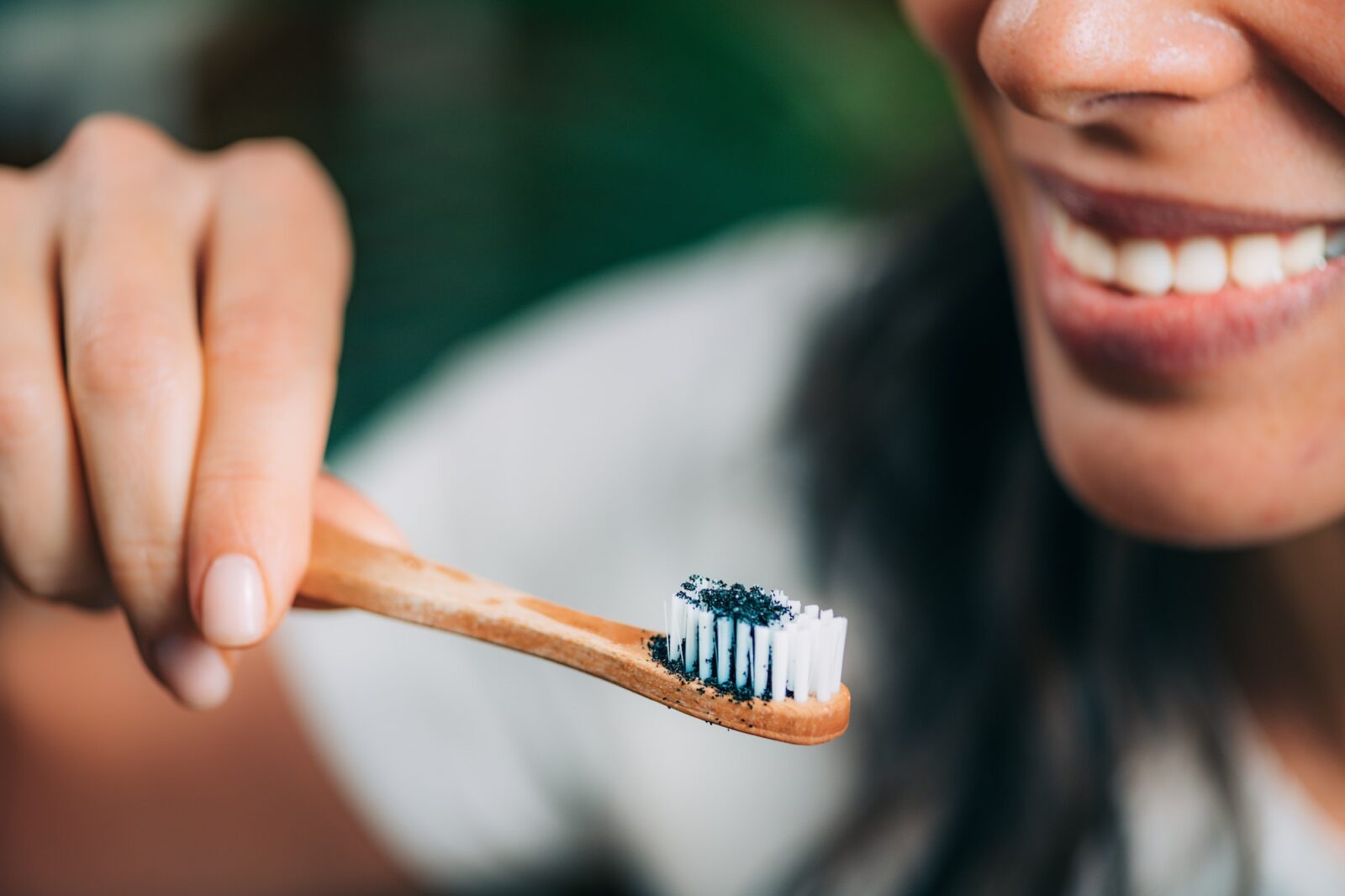
Scrubbing materials, also known as tooth abrasives, are substances that are used to scrub the surface of the teeth to remove stains and improve the overall appearance of the smile. Some common scrubbing materials include baking soda, salt, and charcoal.
Method
To use a scrubbing material for teeth whitening, you will need to follow the specific instructions for the product you are using. For example, you may need to mix a small amount of the scrubbing material with water or toothpaste to create a paste, or you may need to rub the material directly on your teeth. It is important to be cautious when using scrubbing materials, as some substances, such as baking soda or salt, may be abrasive and may cause damage to the teeth or gums if used improperly.
Types
There are several types of scrubbing materials that are commonly used for teeth whitening, including baking soda, salt, and charcoal. Baking soda is a common household ingredient that is claimed to have teeth-whitening properties. Salt is another common scrubbing material that is claimed to have antibacterial properties and to help remove stains from the teeth. Charcoal is a newer and less common scrubbing material that is claimed to have detoxifying and teeth-whitening properties.
Brands
There are many different brands of scrubbing materials for teeth whitening, and the best choice for you may depend on your personal preferences and needs. Some popular brands of scrubbing materials include Arm & Hammer, Colgate, and Simply White.
Candidates
Scrubbing materials for teeth whitening may be suitable for people who are looking for an inexpensive and easy way to improve the appearance of their teeth. However, it is important to be cautious when using scrubbing materials, as their effectiveness may vary and they may not be backed by scientific evidence. Some scrubbing materials, such as those that are abrasive or acidic, may not be suitable for people with sensitive teeth or gums.
Results
The results of using scrubbing materials for teeth whitening may vary, as these products are not necessarily backed by scientific evidence. Some people may find that scrubbing materials are effective at whitening the teeth and improving the overall appearance of the smile. Others may not see any significant results or may experience negative side effects, such as sensitivity or irritation of the gums or teeth.
Risks
There are several risks associated with using scrubbing materials for teeth whitening, including the potential for negative side effects, such as sensitivity or irritation of the gums or teeth. Some scrubbing materials, such as those that are abrasive or acidic, may cause damage to the teeth or gums if used improperly. It is important to be cautious when using scrubbing materials and to follow the specific instructions for the product you are using.
Cost
The cost of using scrubbing materials for teeth whitening may vary, depending on the specific product you are using. Some scrubbing materials, such as baking soda or salt, are relatively inexpensive and can be found in most kitchens. Others, such as charcoal, may be more expensive and may require the purchase of specialty products.
Feedback
Feedback on using scrubbing materials for teeth whitening is mixed, as some people may find these products to be effective and others may not. Some people may also experience negative side effects, such as sensitivity or irritation of the gums or teeth.
Aftercare
Aftercare for using scrubbing materials for teeth whitening may vary depending on the specific product you are using. It is important to follow the specific instructions for the product and to be cautious when using scrubbing materials, as some substances, such as baking soda or salt, may be abrasive and may cause damage to the teeth or gums if used improperly.
Citrus Fruits

Citrus fruits, such as lemons and oranges, are claimed to have teeth whitening properties due to their high citric acid content. Some people use citrus fruits as a natural home remedy for whitening their teeth.
Method
To use citrus fruits for teeth whitening, you will need to follow the specific instructions for the product you are using. For example, you may need to rub a slice of lemon or orange on your teeth, or you may need to mix the juice of citrus fruit with water or toothpaste to create a paste. It is important to be cautious when using citrus fruits, as the citric acid in these fruits may be abrasive and may cause damage to the teeth or gums if used improperly.
Types
There are several types of citrus fruits that are claimed to have teeth-whitening properties, including lemons, oranges, and grapefruits. These fruits can be used in a variety of ways for teeth whitening, such as rubbing the peel or flesh on the teeth or mixing the juice with water or toothpaste to create a paste.
Brands
There are no specific brands of citrus fruits for teeth whitening, as these products are natural and can be found at most grocery stores.
Candidates
Citrus fruits for teeth whitening may be suitable for people who are looking for a natural or inexpensive way to improve the appearance of their teeth. However, it is important to be cautious when using citrus fruits, as their effectiveness may vary and they may not be backed by scientific evidence. Citrus fruits, due to their high citric acid content, may not be suitable for people with sensitive teeth or gums.
Results
The results of using citrus fruits for teeth whitening may vary, as these products are not necessarily backed by scientific evidence. Some people may find that citrus fruits are effective at whitening teeth and improving the overall appearance of the smile. Others may not see any significant results or may experience negative side effects, such as sensitivity or irritation of the gums or teeth.
Risks
There are several risks associated with using citrus fruits for teeth whitening, including the potential for negative side effects, such as sensitivity or irritation of the gums or teeth. Citrus fruits, due to their high citric acid content, may cause damage to the teeth or gums if used improperly. It is important to be cautious when using citrus fruits and to follow the specific instructions for the product you are using.
Cost
The cost of using citrus fruits for teeth whitening may vary, depending on the specific product you are using. Citrus fruits, such as lemons and oranges, are generally inexpensive and can be found at most grocery stores.
Feedback
Feedback on using citrus fruits for teeth whitening is mixed, as some people may find these products to be effective and others may not. Some people may also experience negative side effects, such as sensitivity or irritation of the gums or teeth.
Aftercare
Aftercare for using citrus fruits for teeth whitening may vary depending on the specific product you are using. It is important to follow the specific instructions for the product and to be cautious when using citrus fruits, as the citric acid in these fruits may be abrasive and may cause damage to the teeth or gums if used improperly.
Spices
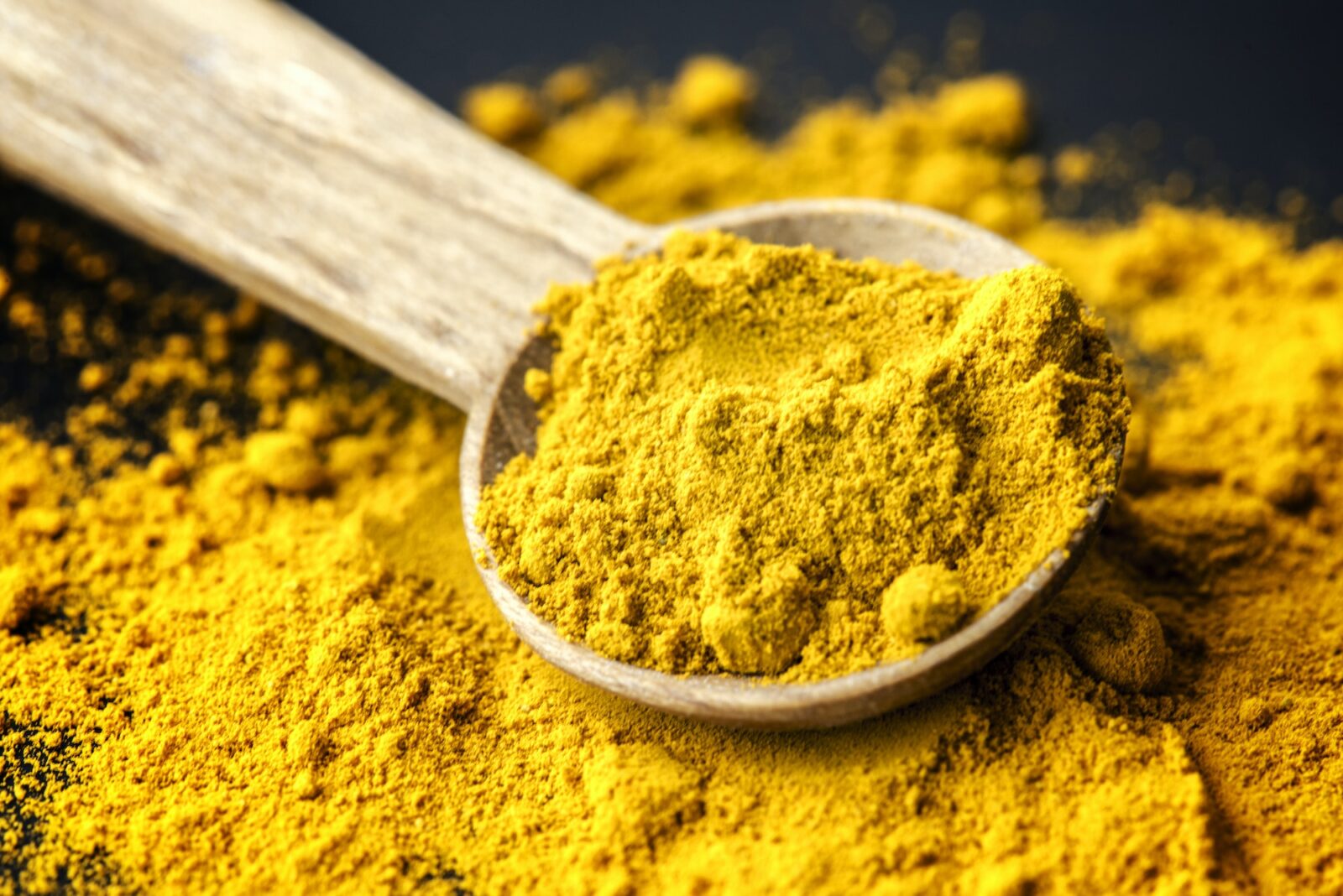
Some spices, such as turmeric and cumin, are claimed to have teeth-whitening properties due to their antioxidant content. Some people use spices as a natural home remedy for whitening their teeth.
Method
To use spices for teeth whitening, you will need to follow the specific instructions for the product you are using. For example, you may need to mix a small amount of the spice with water or toothpaste to create a paste, or you may need to rub the spice directly on your teeth. It is important to be cautious when using spices, as some substances, such as turmeric or cumin, may be abrasive and may cause damage to the teeth or gums if used improperly.
Types
There are several types of spices that are claimed to have teeth-whitening properties, including turmeric, cumin, and cloves. These spices can be used in a variety of ways for teeth whitening, such as mixing with water or toothpaste to create a paste or rubbing directly on the teeth.
Brands
There are no specific brands of spices for teeth whitening, as these products are natural and can be found at most grocery stores or spice shops.
Candidates
Spices for teeth whitening may be suitable for people who are looking for a natural or inexpensive way to improve the appearance of their teeth. However, it is important to be cautious when using spices, as their effectiveness may vary and they may not be backed by scientific evidence. Some spices, such as those that are abrasive or acidic, may not be suitable for people with sensitive teeth or gums.
Results
The results of using spices for teeth whitening may vary, as these products are not necessarily backed by scientific evidence. Some people may find that spices are effective at whitening the teeth and improving the overall appearance of the smile. Others may not see any significant results or may experience negative side effects, such as sensitivity or irritation of the gums or teeth.
Risks
There are several risks associated with using spices for teeth whitening, including the potential for negative side effects, such as sensitivity or irritation of the gums or teeth. Some spices, such as those that are abrasive or acidic, may cause damage to the teeth or gums if used improperly. It is important to be cautious when using spices and to follow the specific instructions for the product you are using.
Cost
The cost of using spices for teeth whitening may vary, depending on the specific product you are using. Some spices, such as turmeric and cumin, are relatively inexpensive and can be found at most grocery stores or spice shops. Others, such as cloves, may be more expensive and may require the purchase of specialty products.
Feedback
Feedback on using spices for teeth whitening is mixed, as some people may find these products to be effective and others may not. Some people may also experience negative side effects, such as sensitivity or irritation of the gums or teeth.
Aftercare
Aftercare for using spices for teeth whitening may vary depending on the specific product you are using. It is important to follow the specific instructions for the product and to be cautious when using spices, as some substances, such as turmeric or cumin, may be abrasive and may cause damage to the teeth or gums if used improperly.
Oil Pulling
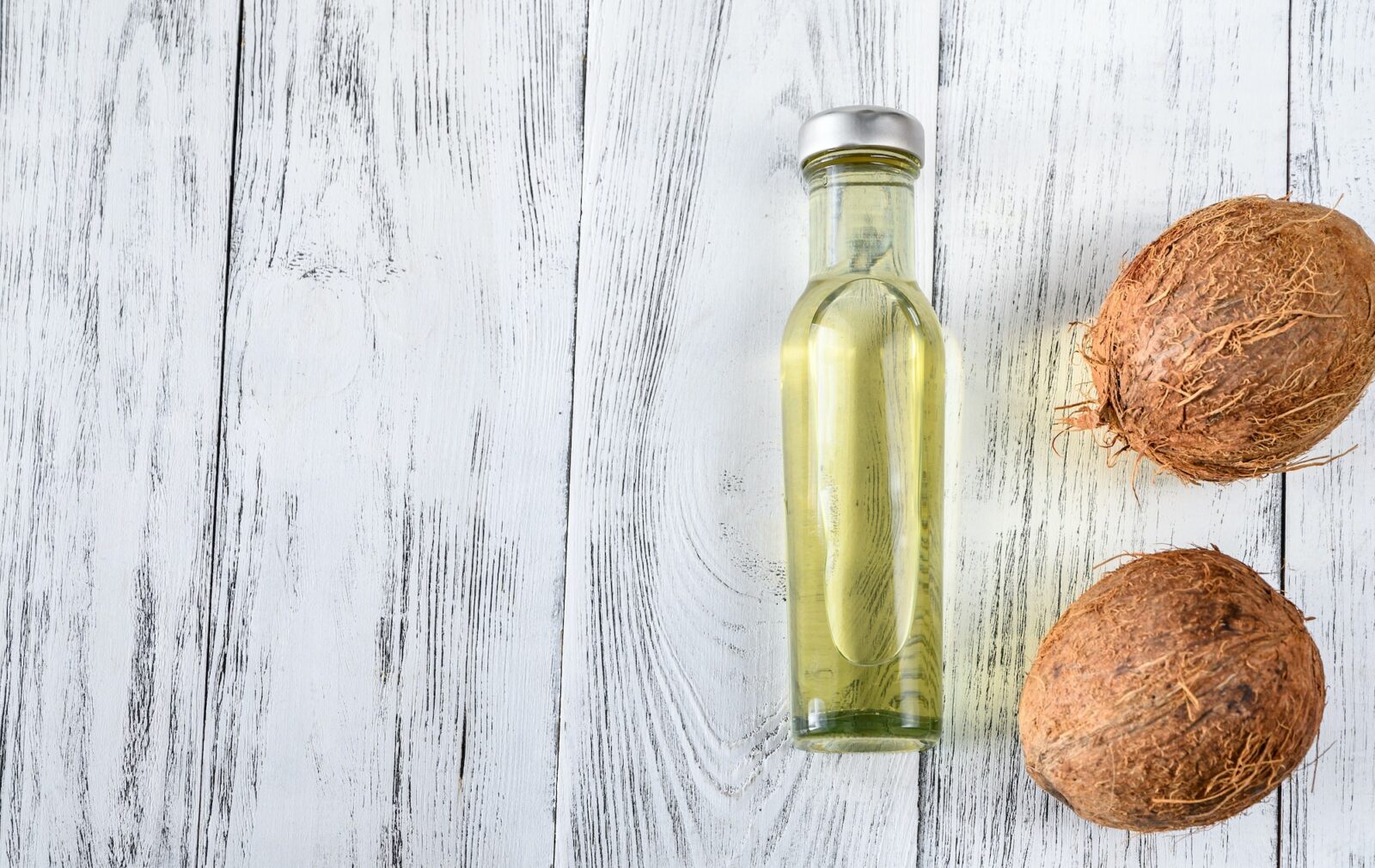
Oil pulling, also known as oil swishing, is a traditional Ayurvedic practice in which oil, such as coconut oil or sesame oil, is swished around in the mouth for a period of time to improve oral hygiene and overall health. Some people use oil pulling as a natural home remedy for whitening their teeth.
Method
To use oil for teeth whitening, you will need to follow the specific instructions for the product you are using. For example, you may need to swish a small amount of oil in your mouth for a certain period of time, or you may need to mix the oil with water or toothpaste to create a paste. It is important to be cautious when using oil, as some substances, such as coconut oil or sesame oil, may cause negative side effects if used improperly.
Types
There are several types of oil that are used for oil pulling, including coconut oil, sesame oil, and sunflower oil. These oils can be used in a variety of ways for teeth whitening, such as swishing in the mouth or mixing with water or toothpaste to create a paste.
Brands
There are many different brands of oil for oil pulling, and the best choice for you may depend on your personal preferences and needs. Some popular brands of oil for oil pulling include Nutiva, Viva Naturals, and Dr. Bronner’s.
Candidates
Oil for teeth whitening may be suitable for people who are looking for a natural or inexpensive way to improve the appearance of their teeth. However, it is important to be cautious when using oil, as its effectiveness may vary and it may not be backed by scientific evidence. Oil, due to its oily nature, may not be suitable for people with certain medical conditions or for those who are allergic to certain types of oil.
Results
The results of using oil for teeth whitening may vary, as this product is not necessarily backed by scientific evidence. Some people may find that oil is effective at whitening the teeth and improving the overall appearance of the smile. Others may not see any significant results or may experience negative side effects, such as sensitivity or irritation of the gums or teeth.
Risks
There are several risks associated with using oil for teeth whitening, including the potential for negative side effects, such as sensitivity or irritation of the gums or teeth. Oil may also cause negative side effects if swallowed, as it may cause digestive issues. It is important to be cautious when using oil and to follow the specific instructions for the product you are using.
Cost
The cost of using oil for teeth whitening may vary, depending on the specific product you are using. Some oils, such as coconut oil or sesame oil, are relatively inexpensive and can be found at most grocery stores or health food stores. Others, such as specialty oils, may be more expensive and may require the purchase of specialty products.
Feedback
Feedback on using oil for teeth whitening is mixed, as some people may find this product to be effective and others may not. Some people may also experience negative side effects, such as sensitivity or irritation of the gums or teeth.
Aftercare
Aftercare for using oil for teeth whitening may vary depending on the specific product you are using. It is important to follow the specific instructions for the product and to be cautious when using oil, as some substances may cause negative side effects if used improperly. It is also a good idea to brush and floss your teeth regularly to maintain good oral hygiene and to seek the advice of a dental professional if you have any concerns about the health of your teeth or gums
Over-the-Counter Products/Take-Home Kits
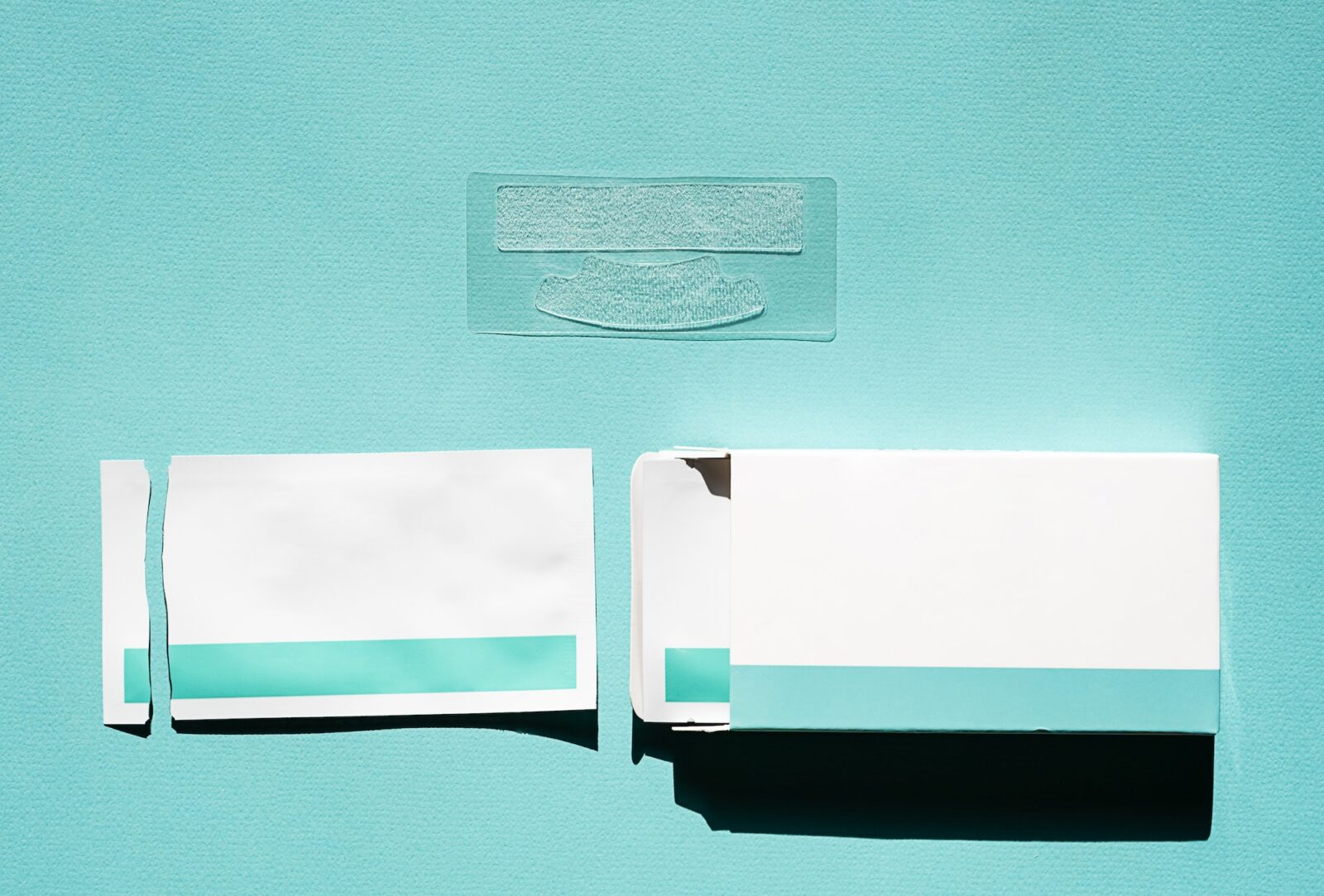
Over-the-counter (OTC) methods for teeth whitening include products such as strips, toothpaste, and mouthwash that are available for purchase without a prescription. These methods are typically less expensive and more convenient than professional treatments, but they may also be less effective and take longer to produce results.
| Method | Effectiveness | Speed | Longevity | Cost | Feedback |
|---|---|---|---|---|---|
| Toothpaste | Low | Slow | Short | Low | Mixed |
| Strips | Low | Slow | Short | Low-Moderate | Mixed |
| Trays | High | Slow | Moderate | Moderate | Positive |
| Pens | Low | Slow | Short | Low-Moderate | Mixed |
| Syringes | High | Fast | Short | Moderate | Positive |
| Mouthwash | Low | Slow | Short | Low | Mixed |
| Gum | Low | Slow | Short | Low | Mixed |
| Lozenge | Low | Slow | Short | Low | Mixed |
| LED | High | Fast | Short | High | Positive |
| Spray | Low | Slow | Short | Low-Moderate | Mixed |
Toothpaste
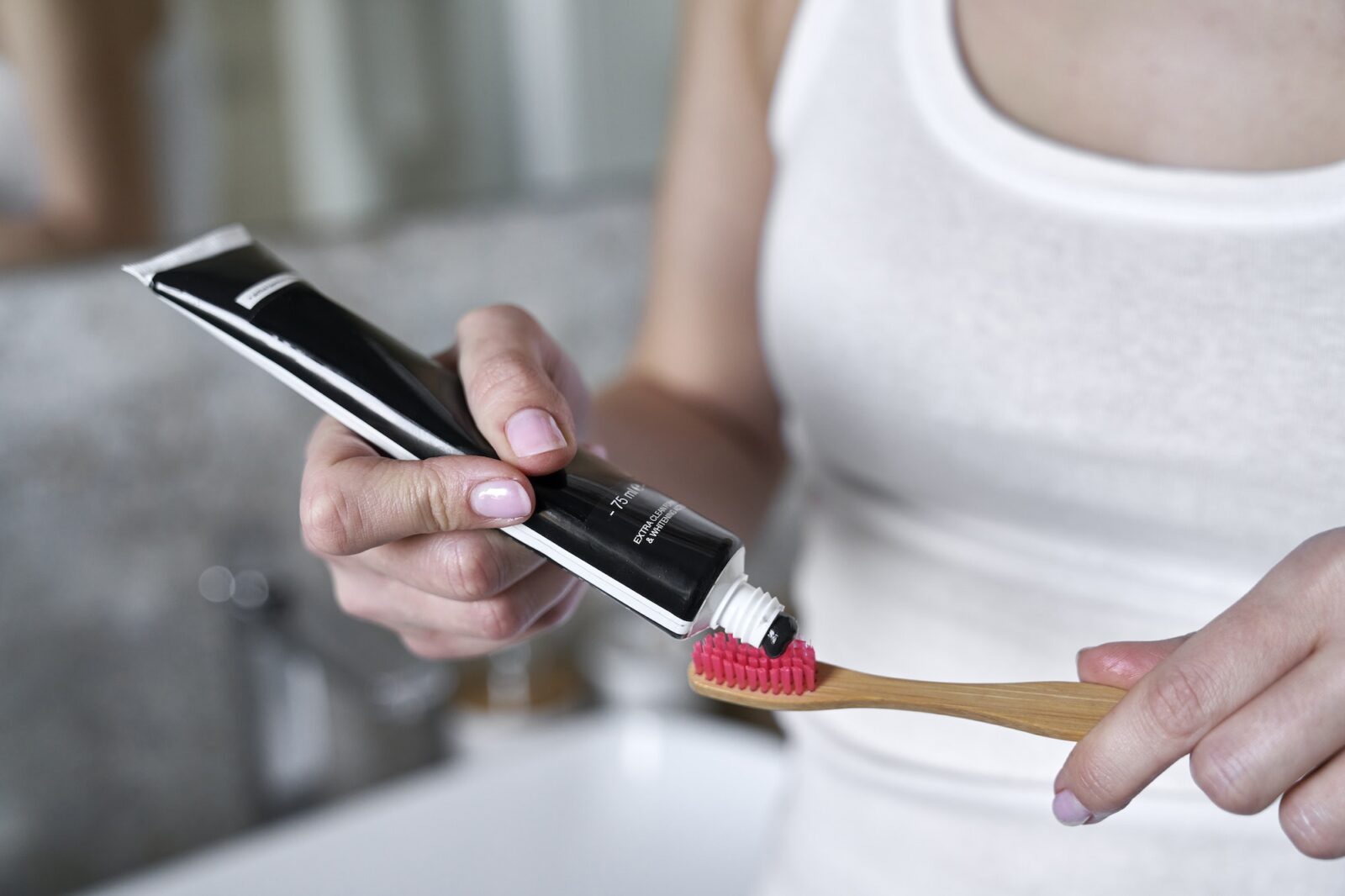
Toothpaste is a common over-the-counter solution for teeth whitening. It is applied directly to the teeth using a toothbrush.
Method
To use toothpaste for teeth whitening, simply brush your teeth with the toothpaste as you would normally do. It is recommended to brush for at least two minutes, twice a day.
Types
There are several types of toothpaste available for whitening teeth, including those with abrasive agents to remove surface stains, those with bleaching agents to penetrate and whiten the tooth enamel, and those with enzymes to break down stain-causing compounds. It is important to choose a toothpaste that is appropriate for your specific needs and desired results.
Brands
Some popular brands of toothpaste that offer whitening benefits include Crest, Colgate, and Rembrandt. It is important to carefully read the labels and ingredients of the toothpaste to ensure that it will be effective and safe for your use.
Candidates
Most people can use toothpaste for teeth whitening, as long as they do not have sensitive teeth or gums. If you have sensitive teeth or gums, it is important to choose a toothpaste that is formulated for sensitive teeth and to use it with caution.
Results
Toothpaste can be effective in removing surface stains and brightening the overall appearance of the teeth. However, it may not be as effective at whitening the teeth as other methods, such as professional treatments or at-home kits.
Risks
Toothpaste is generally safe to use for teeth whitening. However, if you have sensitive teeth or gums, it may cause irritation or discomfort. In addition, some toothpaste may contain ingredients that can cause allergic reactions in some individuals.
Cost
Toothpaste is a relatively inexpensive option for teeth whitening. Prices can vary depending on the brand and type of toothpaste, but it is generally more affordable than professional treatments or at-home kits.
Feedback
Overall, toothpaste is a convenient and easy way to help whiten teeth. However, results may vary and it may not be as effective as other methods.
Aftercare
After using toothpaste for teeth whitening, it is important to continue practicing good oral hygiene by brushing and flossing regularly and visiting the dentist for regular cleanings. This will help maintain the whiteness of your teeth and prevent future staining.
Strips
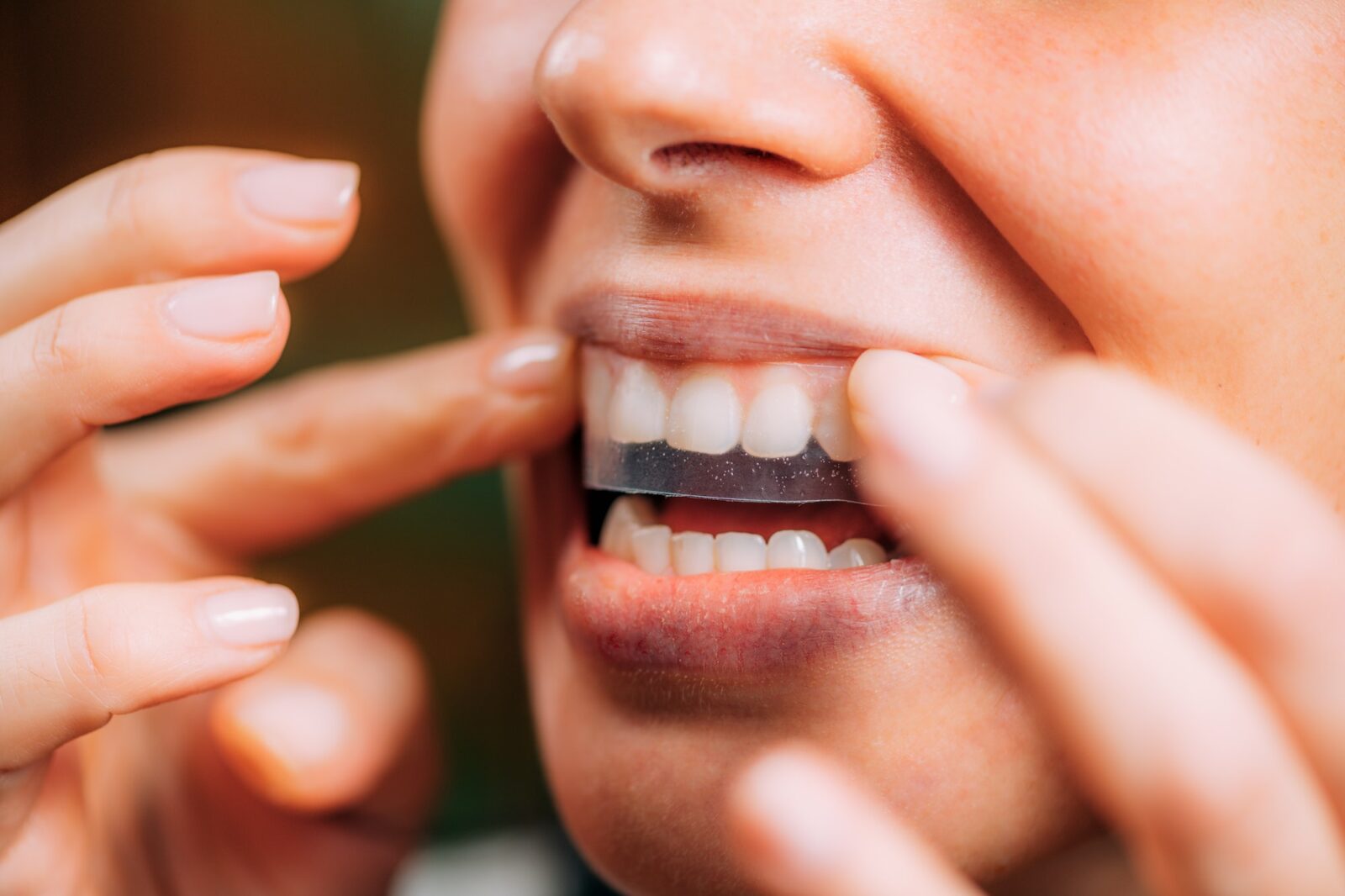
Method
Strips are a popular OTC method for teeth whitening. These thin, flexible strips are coated with a peroxide-based whitening gel and are applied to the teeth for a specified period of time, usually 20-30 minutes.
Types
There are two types of strips available: strips that are applied to the front of the teeth (called “frontal strips”) and strips that are applied to both the front and back of the teeth (called “full coverage strips”).
Brands
There are several brands of teeth whitening strips available, including Crest Whitestrips, Listerine Whitening Strips, and Pola Day White. It is important to follow the manufacturer’s instructions for use when using teeth whitening strips to ensure the best results and to minimize the risk of adverse effects.
Candidates
Teeth whitening strips may be an appropriate option for people who have mild to moderate tooth discoloration and who want to improve the appearance of their teeth without the cost and inconvenience of professional treatments. However, people with severe tooth discoloration or dental issues such as cavities or gum disease may not be good candidates for this type of treatment.
Results
Teeth whitening strips can produce noticeable results in a short period of time, but the results may not be as dramatic as those achieved with professional treatments. The results of teeth whitening with strips may also vary depending on the severity of the discoloration and the type of strips used.
Risks
There are some risks associated with the use of teeth whitening strips, including sensitivity or discomfort, especially if the strips are used for longer periods of time than recommended or if the person has sensitive teeth. It is important to follow the manufacturer’s instructions for use to minimize the risk of adverse effects.
Cost
Teeth whitening strips are generally less expensive than professional treatments, but the cost can vary depending on the brand and type of strips used. It is a good idea to compare prices and read reviews before purchasing teeth whitening strips to find the most effective and affordable option.
Feedback
Feedback from people who have used teeth whitening strips is generally positive, with many reporting that the strips are easy to use and produce noticeable results in a short period of time. However, some people may be disappointed with the results of teeth whitening with strips if they have severe tooth discoloration or if they have unrealistic expectations about the potential results.
Aftercare
Aftercare for teeth whitening with strips is generally simple. It is important to continue practicing good oral hygiene habits, including brushing and flossing regularly and using fluoride toothpaste, to help maintain the results of teeth whitening and to prevent new stains from forming. It is also a good idea to avoid consuming stain-causing foods and drinks, such as coffee, tea, and red wine, and to avoid tobacco use, as these can all contribute to tooth discoloration.
Trays

Method
Teeth whitening trays are a popular OTC method for teeth whitening. These trays are made to fit the shape of your teeth and are filled with a peroxide-based whitening gel. The trays are worn for a specified period of time, usually a few hours a day or overnight, depending on the product.
Types
There are two main types of dental whitening trays: pre-filled and custom-fitted.
Pre-filled trays are ready-to-use trays that are pre-loaded with a whitening gel. They are typically disposable and come in a one-size-fits-all design. They are a convenient and easy option for people who want to try teeth whitening at home.
Custom-fitted trays, on the other hand, are trays that are made to fit the individual’s teeth. They are typically made by taking an impression of the person’s teeth and then creating a mold based on that impression. Custom-fitted trays are designed to provide a better fit and a more effective whitening treatment, as the gel is able to come into direct contact with all surfaces of the teeth.
Both types of dental whitening trays can be effective, but custom-fitted trays tend to be more comfortable and produce better results, as they are specifically designed to fit the individual’s teeth.
Brands
There are several brands of teeth whitening trays available, including Crest Whitestrips Premium, Listerine Whitening Trays, and Pola Office Whitening. It is important to follow the manufacturer’s instructions for use when using teeth whitening trays to ensure the best results and to minimize the risk of adverse effects.
Candidates
Teeth whitening trays may be an appropriate option for people who have mild to moderate tooth discoloration and who want to improve the appearance of their teeth without the cost and inconvenience of professional treatments. However, people with severe tooth discoloration or dental issues such as cavities or gum disease may not be good candidates for this type of treatment.
Results
Teeth whitening with trays can produce noticeable results in a short period of time, but the results may not be as dramatic as those achieved with professional treatments. The results of teeth whitening with trays may also vary depending on the severity of the discoloration and the type of trays used.
Risks
There are some risks associated with the use of teeth whitening trays, including sensitivity or discomfort, especially if the trays are used for longer periods of time than recommended or if the person has sensitive teeth. It is important to follow the manufacturer’s instructions for use to minimize the risk of adverse effects.
Cost
Teeth whitening trays are generally less expensive than professional treatments, but the cost can vary depending on the brand and type of trays used. Custom-made trays may be more expensive than OTC trays, but they may also provide a better fit and more effective results. It is a good idea to compare prices and read reviews before purchasing teeth whitening trays to find the most effective and affordable option.
Feedback
Feedback from people who have used teeth whitening trays is generally positive, with many reporting that the trays are easy to use and produce noticeable results in a short period of time. However, some people may be disappointed with the results of teeth whitening with trays if they have severe tooth discoloration or if they have unrealistic expectations about the potential results.
Aftercare
Aftercare for teeth whitening with trays is generally simple. It is important to continue practicing good oral hygiene habits, including brushing and flossing regularly and using fluoride toothpaste, to help maintain the results of teeth whitening and to prevent new stains from forming. It is also a good idea to avoid consuming stain-causing foods and drinks, such as coffee, tea, and red wine, and to avoid tobacco use, as these can all contribute to tooth discoloration.
Pens

Over-the-counter (OTC) teeth whitening pens are small, portable, and easy to use, making them a convenient option for people who want to touch up their teeth or maintain the results of professional teeth whitening treatments.
Method
These pens contain a peroxide-based whitening gel that is applied to the surface of the teeth using a brush or roller applicator. The pens are typically used a few times a day for a period of several days or weeks, depending on the product.
Types
There are several types of OTC teeth whitening pens available, including pens that contain a lower concentration of peroxide and pens that contain a higher concentration of peroxide. The concentration of peroxide in the pen can affect the effectiveness of the treatment and the potential for adverse effects. It is important to choose a pen with a concentration of peroxide that is appropriate for your needs and to follow the manufacturer’s instructions for use.
Brands
There are several brands of OTC teeth whitening pens available, including Crest 3D White Luxe Glamorous White Whitestrips, Colgate Optic White Express White Pen, and Glo Brilliant Personal Teeth Whitening Device. It is important to compare prices and read reviews before purchasing a teeth whitening pen to find the most effective and affordable option.
Candidates
Teeth whitening pens may be an appropriate option for people who have mild to moderate tooth discoloration and who want to touch up their teeth or maintain the results of professional teeth whitening treatments. However, people with severe tooth discoloration or dental issues such as cavities or gum disease may not be good candidates for this type of treatment.
Results
Teeth whitening with pens can produce noticeable results in a short period of time, but the results may not be as dramatic as those achieved with professional treatments. The results of teeth whitening with pens may also vary depending on the severity of the discoloration and the type of pen used.
Risks
There are some risks associated with the use of teeth whitening pens, including sensitivity or discomfort, especially if the pens are used for longer periods of time than recommended or if the person has sensitive teeth. It is important to follow the manufacturer’s instructions for use to minimize the risk of adverse effects.
Cost
Teeth whitening pens are generally less expensive than professional treatments, but the cost can vary depending on the brand and type of pen used. It is a good idea to compare prices and read reviews before purchasing a teeth whitening pen to find the most effective and affordable option.
Feedback
Feedback from people who have used teeth-whitening pens is generally positive, with many reporting that the pens are easy to use and produce noticeable results in a short period of time. However, some people may be disappointed with the results of teeth whitening with pens if they have severe tooth discoloration or if they have unrealistic expectations about the potential results.
Aftercare
Aftercare for teeth whitening with pens is generally simple. It is important to continue practicing good oral hygiene habits, including brushing and flossing regularly and using fluoride toothpaste, to help maintain the results of teeth whitening and to prevent new stains from forming. It is also a good idea to avoid consuming stain-causing foods and drinks, such as coffee, tea, and red wine, and to avoid tobacco use, as these can all contribute to tooth discoloration
Syringes
Over-the-counter (OTC) teeth whitening syringes are a type of teeth whitening product that comes in a small, easy-to-use tube or syringe that dispenses a peroxide-based whitening gel.
Method
The gel is applied to the surface of the teeth using a small brush or by placing a small amount of the gel directly on the teeth. The gel is typically left on the teeth for a period of time, ranging from a few minutes to several hours, depending on the product.
Types
There are several types of OTC teeth whitening syringes available, including syringes that contain a lower concentration of peroxide and syringes that contain a higher concentration of peroxide. The concentration of peroxide in the syringe can affect the effectiveness of the treatment and the potential for adverse effects. It is important to choose a syringe with a concentration of peroxide that is appropriate for your needs and to follow the manufacturer’s instructions for use.
Brands
There are several brands of OTC teeth whitening syringes available, including Crest 3D White Professional Effects Whitestrips and Opalescence Go 15% Teeth Whitening Gel. It is important to compare prices and read reviews before purchasing a teeth-whitening syringe to find the most effective and affordable option.
Candidates
Teeth whitening syringes may be an appropriate option for people who have mild to moderate tooth discoloration and who want to touch up their teeth or maintain the results of professional teeth whitening treatments. However, people with severe tooth discoloration or dental issues such as cavities or gum disease may not be good candidates for this type of treatment.
Results
Teeth whitening with syringes can produce noticeable results in a short period of time, but the results may not be as dramatic as those achieved with professional treatments. The results of teeth whitening with syringes may also vary depending on the severity of the discoloration and the type of syringe used.
Risks
There are some risks associated with the use of teeth whitening syringes, including sensitivity or discomfort, especially if the syringes are used for longer periods of time than recommended or if the person has sensitive teeth. It is important to follow the manufacturer’s instructions for use to minimize the risk of adverse effects.
Cost
Teeth whitening syringes are generally less expensive than professional treatments, but the cost can vary depending on the brand and type of syringe used. It is a good idea to compare prices and read reviews before purchasing a teeth-whitening syringe to find the most effective and affordable option.
Feedback
Feedback from people who have used teeth whitening syringes is generally positive, with many reporting that the syringes are easy to use and produce noticeable results in a short period of time. However, some people may be disappointed with the results of teeth whitening with syringes if they have severe tooth discoloration or if they have unrealistic expectations about the potential results.
Aftercare
Aftercare for teeth whitening with syringes is generally simple. It is important to continue practicing good oral hygiene habits, including brushing and flossing regularly and using fluoride toothpaste, to help maintain the results of teeth whitening and to prevent new stains from forming. It is also a good idea to avoid consuming stain-causing foods and drinks, such as coffee, tea, and red wine, and to avoid tobacco use, as these can all contribute to tooth discoloration.
Paint Brushes

Over-the-counter (OTC) teeth whitening paint brushes are a type of teeth whitening product that comes in a small tube or bottle that contains a peroxide-based whitening gel.
Method
The gel is applied to the surface of the teeth using a small brush that is similar to a nail polish brush. The gel is typically left on the teeth for a period of time, ranging from a few minutes to several hours, depending on the product.
Types
There are several types of OTC teeth whitening paint brushes available, including paint brushes that contain a lower concentration of peroxide and paint brushes that contain a higher concentration of peroxide. The concentration of peroxide in the paintbrush can affect the effectiveness of the treatment and the potential for adverse effects. It is important to choose a paintbrush with a concentration of peroxide that is appropriate for your needs and to follow the manufacturer’s instructions for use.
Brands
There are several brands of OTC teeth whitening paintbrushes available, including Smileactives and Colgate Optic White Express White Toothbrush + Whitening Pen. It is important to compare prices and read reviews before purchasing a teeth-whitening paintbrush to find the most effective and affordable option.
Candidates
Teeth whitening paintbrushes may be an appropriate option for people who have mild to moderate tooth discoloration and who want to touch up their teeth or maintain the results of professional teeth whitening treatments. However, people with severe tooth discoloration or dental issues such as cavities or gum disease may not be good candidates for this type of treatment.
Results
Teeth whitening with paint brushes can produce noticeable results in a short period of time, but the results may not be as dramatic as those achieved with professional treatments. The results of teeth whitening with paintbrushes may also vary depending on the severity of the discoloration and the type of paintbrush used.
Risks
There are some risks associated with the use of teeth whitening paint brushes, including sensitivity or discomfort, especially if the paint brushes are used for longer periods of time than recommended or if the person has sensitive teeth. It is important to follow the manufacturer’s instructions for use to minimize the risk of adverse effects.
Cost
Teeth whitening paintbrushes are generally less expensive than professional treatments, but the cost can vary depending on the brand and type of paintbrush used. It is a good idea to compare prices and read reviews before purchasing a teeth-whitening paintbrush to find the most effective and affordable option.
Feedback
Feedback from people who have used teeth-whitening paint brushes is generally positive, with many reporting that the paint brushes are easy to use and produce noticeable results in a short period of time. However, some people may be disappointed with the results of teeth whitening with paint brushes if they have severe tooth discoloration or if they have unrealistic expectations about the potential results.
Aftercare
Aftercare for teeth whitening with paintbrushes is generally simple. It is important to continue practicing good oral hygiene habits, including brushing and flossing regularly and using fluoride toothpaste, to help maintain the results of teeth whitening and to prevent new stains from forming. It is also a good idea to avoid consuming stain-causing foods and drinks, such as coffee, tea, and red wine, and to avoid tobacco use, as these can all contribute to tooth discoloration.
Mouthwash

Method
Over-the-counter (OTC) teeth-whitening mouthwashes are a type of teeth-whitening product that is designed to be swished around in the mouth for a period of time, typically for about one minute, before being spat out. The mouthwash contains a peroxide-based whitening agent that is intended to lift stains from the surface of the teeth. Some OTC teeth-whitening mouthwashes may also contain other ingredients that are intended to freshen breath or provide other oral health benefits.
Types
There are several types of OTC teeth-whitening mouthwashes available, including mouthwashes that contain a lower concentration of peroxide and mouthwashes that contain a higher concentration of peroxide. The concentration of peroxide in the mouthwash can affect the effectiveness of the treatment and the potential for adverse effects. It is important to choose a mouthwash with a concentration of peroxide that is appropriate for your needs and to follow the manufacturer’s instructions for use.
Brands
There are several brands of OTC teeth-whitening mouthwashes available, including Listerine Whitening Quick Dissolving Strips and Crest 3D White Whitening Mouthwash. It is important to compare prices and read reviews before purchasing a teeth-whitening mouthwash to find the most effective and affordable option.
Candidates
Teeth whitening mouthwashes may be an appropriate option for people who have mild to moderate tooth discoloration and who want to touch up their teeth or maintain the results of professional teeth whitening treatments. However, people with severe tooth discoloration or dental issues such as cavities or gum disease may not be good candidates for this type of treatment.
Results
Teeth whitening with mouthwashes can produce noticeable results in a short period of time, but the results may not be as dramatic as those achieved with professional treatments. The results of teeth whitening with mouthwashes may also vary depending on the severity of the discoloration and the type of mouthwash used.
Risks
There are some risks associated with the use of teeth-whitening mouthwashes, including sensitivity or discomfort, especially if the mouthwashes are used for longer periods of time than recommended or if the person has sensitive teeth. It is important to follow the manufacturer’s instructions for use to minimize the risk of adverse effects.
Cost
Teeth whitening mouthwashes are generally less expensive than professional treatments, but the cost can vary depending on the brand and type of mouthwash used. It is a good idea to compare prices and read reviews before purchasing a teeth-whitening mouthwash to find the most effective and affordable option.
Feedback
Feedback from people who have used teeth-whitening mouthwashes is generally positive, with many reporting that the mouthwashes are easy to use and produce noticeable results in a short period of time. However, some people may be disappointed with the results of teeth whitening with mouthwashes if they have severe tooth discoloration or if they have unrealistic expectations about the potential results.
Aftercare
Aftercare for teeth whitening with mouthwashes is generally simple. It is important to continue practicing good oral hygiene habits, including brushing and flossing regularly and using fluoride toothpaste, to help maintain the results of teeth whitening and to prevent new stains from forming. It is also a good idea to avoid consuming stain-causing foods and drinks, such as coffee, tea, and red wine, and to avoid tobacco use, as these can all contribute to tooth discoloration
Gum
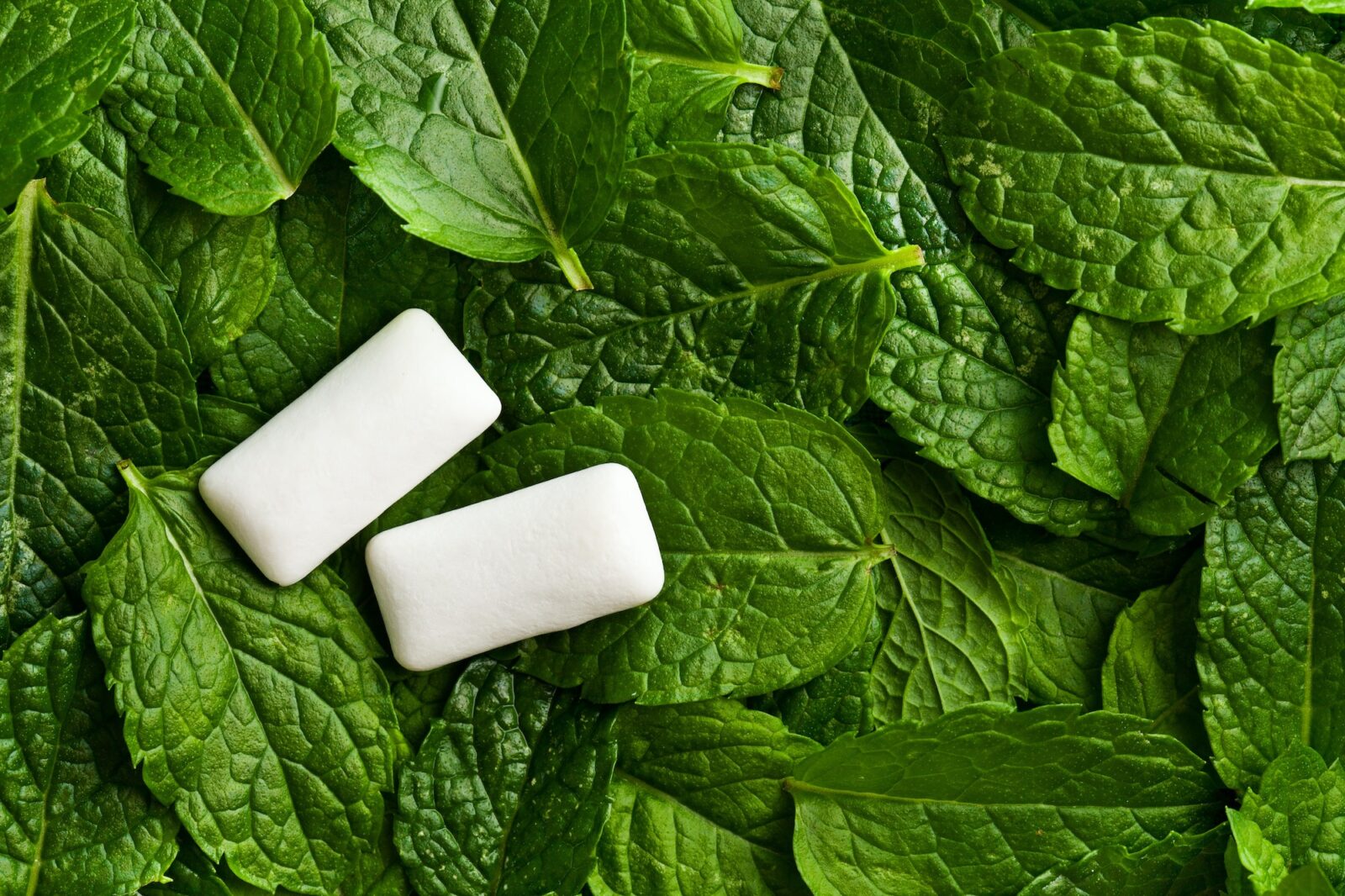
Method
Whitening gum is a type of over-the-counter teeth whitening method that is designed to be chewed like regular gum. It typically contains ingredients such as hydrogen peroxide or carbamide peroxide that can help to whiten teeth over time.
Types
There are a variety of different types of whitening gum available, including gums that contain different concentrations of whitening agents, gums that are designed to be used for short periods of time, and gums that are designed to be used for longer periods of time.
Brands
Some popular brands of whitening gum include Crest, Colgate, and Sensodyne.
Candidates
Whitening gum is suitable for most people who are looking to whiten their teeth. However, it may not be suitable for individuals with sensitive teeth or gums, or for individuals who are allergic to the ingredients in the gum.
Results
The results of using whitening gum can vary depending on the brand and the type of gum used. Some users may notice a noticeable difference in the whiteness of their teeth after just a few weeks of use, while others may not see significant results until several months of use.
Risks
The risks associated with whitening gum are generally considered to be low. However, some users may experience tooth sensitivity or gum irritation as a result of using the gum.
Cost
The cost of whitening gum can vary depending on the brand and the type of gum used. Some gums can be purchased for as little as a few dollars per pack, while others can cost several hundred dollars for longer-term treatment.
Feedback
Feedback for whitening gum is generally positive. Many users report that it is a convenient and easy way to whiten their teeth and that the results are noticeable. Some users have also reported that the gum can help to freshen breath.
Aftercare
To maintain the results of whitening gum, it is important to continue using the gum as directed and to maintain good oral hygiene practices, including brushing and flossing regularly. It is also important to avoid consuming stain-causing foods and drinks and to see a dentist regularly for check-ups and professional cleanings.
Lozenge
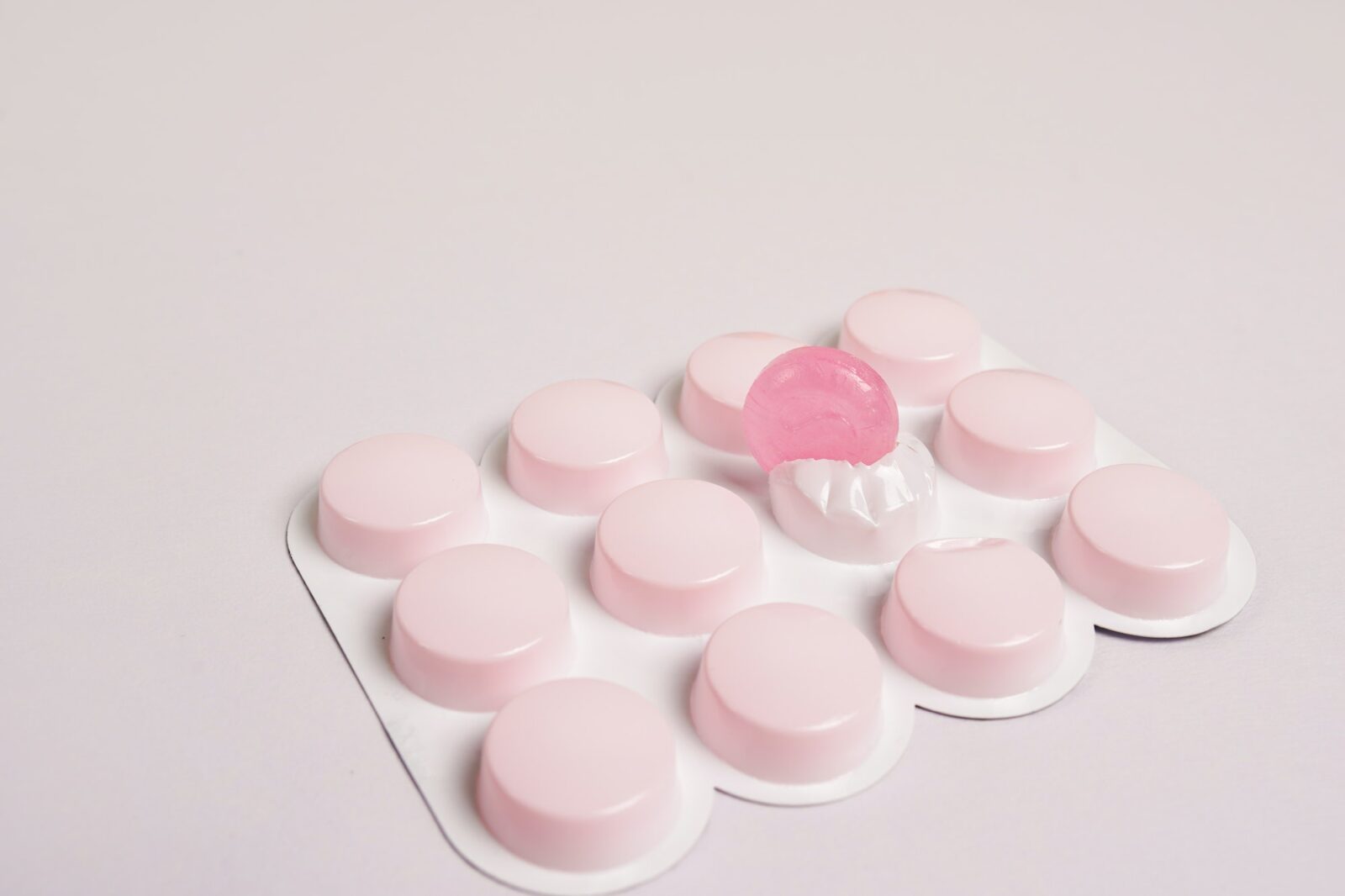
Method
Whitening lozenges are oral supplements that are meant to be dissolved in the mouth in order to whiten teeth. They typically contain ingredients such as hydrogen peroxide or carbamide peroxide that work to break down surface stains on the teeth.
Types
There are various types of whitening lozenges available, including those that are meant to be used regularly for maintenance, as well as those that are used for more intensive whitening treatments.
Brands
Some popular brands that offer whitening lozenges include Crest, Colgate, and Opalescence.
Candidates
Whitening lozenges are best suited for individuals who have mild to moderate staining on their teeth, as they are not as effective as professional treatments for severe staining. They are also not recommended for individuals with sensitive teeth or gums.
Results
The results of using whitening lozenges can vary depending on the type and brand of product used, as well as the individual’s oral hygiene habits. Typically, users can expect to see a slight improvement in the whiteness of their teeth, but significant changes may take multiple treatments.
Risks
There are minimal risks associated with using whitening lozenges, but it is important to follow the instructions for use and not overuse the product as it may cause tooth sensitivity.
Cost
The cost of whitening lozenges can vary depending on the brand and type of product. They are generally more affordable than professional treatments but may require multiple treatments in order to achieve desired results.
Feedback
Feedback for whitening lozenges is generally positive, with users reporting that they are easy to use and convenient and that they have seen an improvement in the whiteness of their teeth.
Aftercare
After using whitening lozenges, it is important to maintain good oral hygiene by brushing and flossing regularly and limiting the consumption of stain-causing foods and drinks. Users should also be mindful of any tooth sensitivity that may occur, and consult a dentist if it becomes severe or persistent.
LED
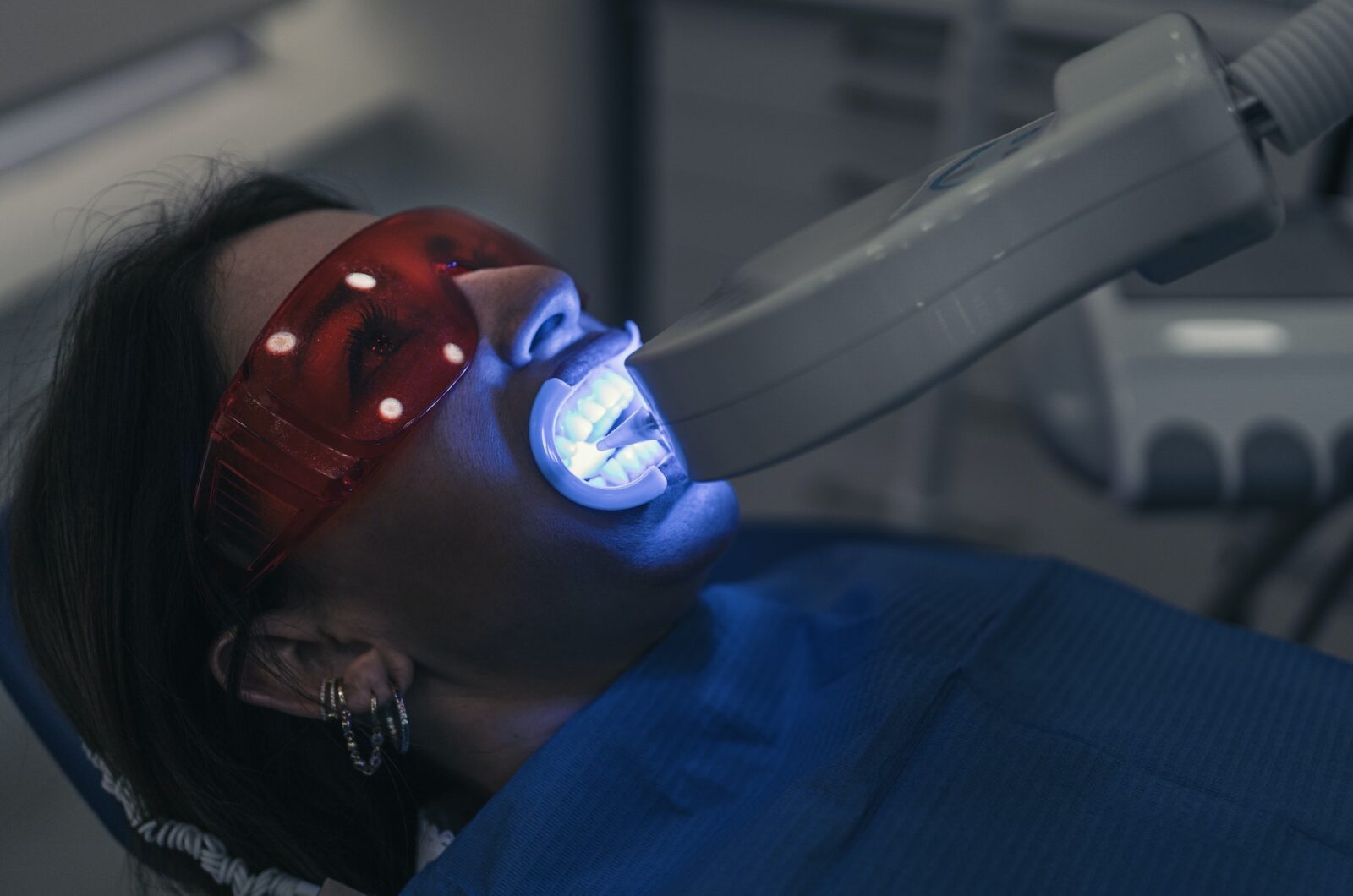
Method
LED teeth whitening kits use a combination of a whitening gel or strip and a specialized LED light to accelerate the whitening process. The light is typically blue or white and is activated when placed over the gel-covered teeth.
Types
There are a variety of LED teeth whitening kits available on the market, ranging from those that can be used in the comfort of your own home to professional-grade kits used in dental offices. Some kits are designed for specific types of stains, such as those caused by smoking or the consumption of certain foods and beverages.
Brands
Some popular brands of LED teeth whitening kits include GLO Science, Philips Zoom, and AuraGlow.
Candidates
LED teeth whitening kits are generally safe for most people, but it is always best to consult with a dentist before starting any whitening treatment. Individuals with sensitive teeth, receding gums, or other oral health issues may not be good candidates for this type of treatment.
Results
LED teeth whitening kits can provide noticeable results in as little as one treatment, with the potential for even more dramatic results with continued use. However, results may vary depending on the type and severity of the stains being treated.
Risks
There are a few potential risks associated with LED teeth whitening kits, such as tooth sensitivity and damage to tooth enamel. It’s important to follow the instructions carefully and not overuse the treatment.
Cost
LED teeth whitening kits can vary greatly in cost, with some kits costing as little as $20 and others costing several hundred dollars. Some kits are designed for one-time use while others can be used for multiple treatments.
Feedback
Overall, LED teeth whitening kits generally receive positive feedback, with many users reporting noticeable results after just one treatment. However, it is important to note that results can vary depending on the individual and the type of stains being treated.
Aftercare
After using an LED teeth whitening kit, it’s important to maintain good oral hygiene by brushing and flossing regularly and avoiding stain-causing foods and drinks. It’s also a good idea to follow up with your dentist to ensure that your teeth are healthy and that the whitening treatment has not caused any damage. It is also important to not overuse the treatment as it can cause tooth sensitivity and damage to tooth enamel.
Spray
Method
Whitening sprays typically use a hydrogen peroxide or carbamide peroxide solution that is sprayed directly onto the teeth. The solution is typically left on for a certain period of time before being rinsed off.
Types
Different brands may offer different concentrations of the active ingredient, as well as different flavors and application methods. Some sprays may be used in conjunction with other whitening products, such as trays or strips.
Brands
Some popular brands of whitening sprays include Colgate Optic White, Crest 3D White, and Luster Pro Light.
Candidates
Whitening sprays may be a good option for individuals who have mild to moderate tooth discoloration and are looking for a convenient and easy-to-use whitening option. They may also be a good option for individuals who have difficulty using other whitening products, such as trays or strips.
Results
Whitening sprays can typically provide noticeable results after a few days of use, with some individuals seeing a difference after just one use. The level of whitening achieved will depend on the concentration of the active ingredient and the length of time the product is used for.
Risks
As with any teeth whitening product, there is a risk of tooth sensitivity and gingival irritation. It is important to follow the instructions for use carefully and to discontinue use if you experience any discomfort.
Cost
Whitening sprays can vary in price, with some options costing around $15-20 per bottle.
Feedback
Overall, whitening sprays have received positive feedback from users, with many reporting easy application and noticeable results. However, some users have complained of a strong taste or burning sensation with certain products.
Aftercare
It is important to maintain good oral hygiene practices while using a whitening spray, including brushing and flossing regularly. To maintain the results achieved with a whitening spray, it may be helpful to use the product on a regular maintenance schedule, as well as avoid stain-causing substances such as coffee and tobacco.
Professional In-Office Treatments
| Method | Effectiveness | Speed | Longevity | Cost | Feedback |
|---|---|---|---|---|---|
| Laser | High | Fast | Short | High | Positive |
| Microabrasion | High | Fast | Short | High | Positive |
Laser
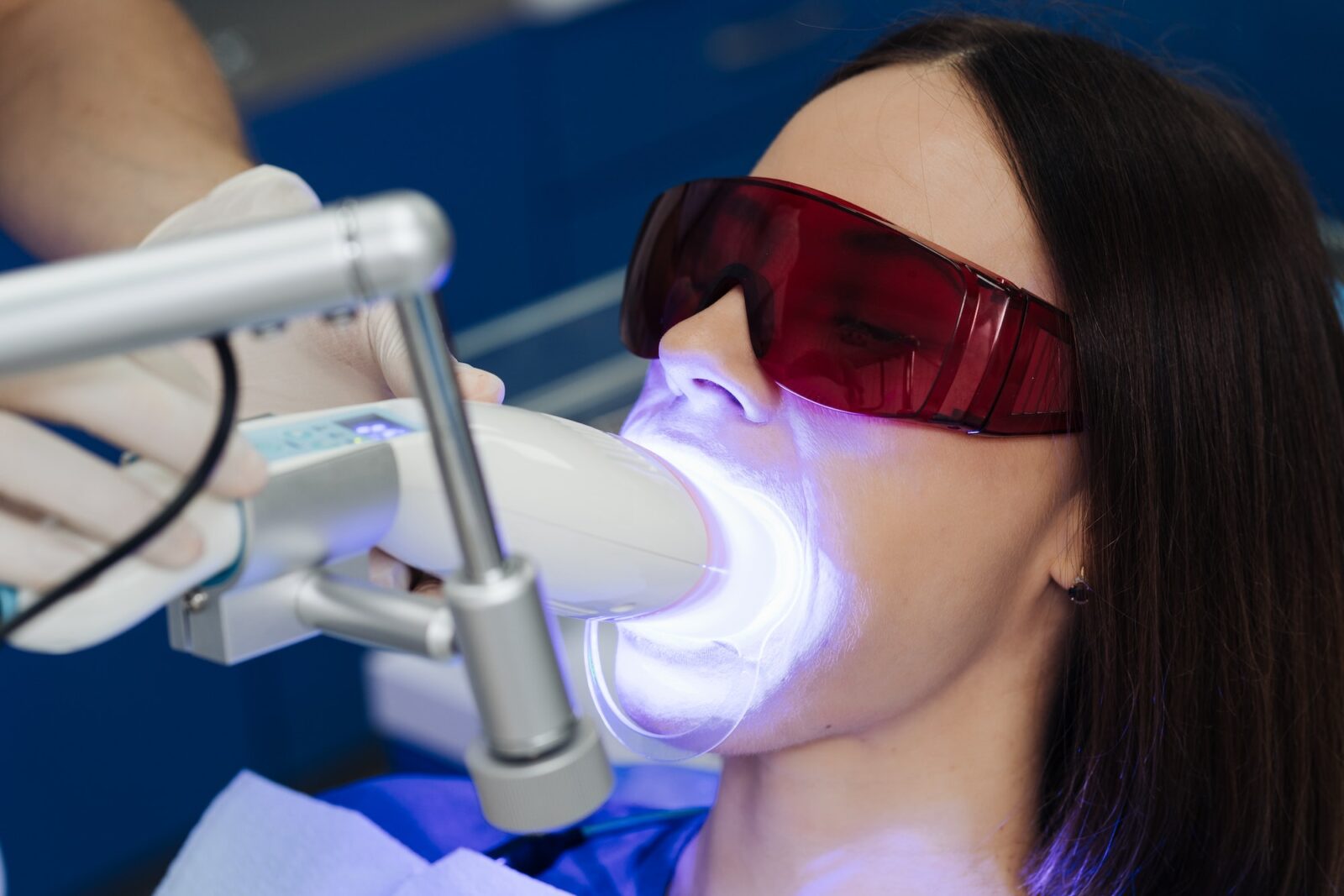
Method
Laser teeth whitening, also known as power whitening or laser bleaching, is a professional in-office teeth whitening treatment that uses a laser or a high-intensity light to accelerate the bleaching process. The dental professional will apply a bleaching gel to the teeth and then use the laser or light to activate the gel and whiten the teeth. The process typically takes about an hour to complete.
Types
There are several different types of laser teeth whitening treatments available, including Enlighten, LaserSmile, and LaserWhite. These treatments may differ in terms of the type of laser or light used, the concentration of the bleaching gel, and the length of treatment time.
Brands
Laser teeth whitening is offered by various brands, including Philips, LaserSmile, and LaserWhite.
Candidates
Laser teeth whitening may be suitable for those who want to achieve noticeable results in a single office visit and are willing to pay for professional treatment. It may not be suitable for those with sensitive teeth or gums, or those who have severe tooth discoloration or other oral health concerns.
Results
Laser teeth whitening may be able to lighten the teeth by several shades in a single office visit. The results may vary depending on the individual’s starting tooth shade and the severity of their tooth discoloration.
Risks
Laser teeth whitening may cause temporary sensitivity or discomfort. It is important to follow the aftercare instructions provided by the dental professional to minimize the risk of adverse effects.
Cost
Laser teeth whitening is typically more expensive than over-the-counter or take-home whitening kits. The cost may vary depending on the type of treatment chosen and the dental professional’s fees.
Feedback
Laser teeth whitening has generally received positive feedback from those who have undergone the treatment. Many people report a noticeable improvement in the appearance of their teeth after the treatment.
Aftercare
It is important to follow the aftercare instructions provided by the dental professional after undergoing laser teeth whitening. This may include avoiding certain foods and beverages, avoiding tobacco use, and practicing good oral hygiene. It is also important to follow up with the dental professional for any necessary touch-ups or maintenance treatments.
Microabrasion
Method
Microabrasion teeth whitening is a professional in-office treatment that involves the use of a specialized instrument to gently sand or polish the surface of the teeth. The dental professional will use a fine abrasive material and water to remove surface stains and discoloration from the teeth. The process typically takes about an hour to complete.
Types
There are several different types of microabrasion teeth whitening treatments available, including crystal microabrasion and diamond microabrasion. These treatments may differ in terms of the type of abrasive material used and the method of application.
Brands
Microabrasion teeth whitening is offered by various brands, including Sapphire, Diamondbrite, and GloScience.
Candidates
Microabrasion teeth whitening may be suitable for those with mild to moderate tooth discoloration or surface stains. It may not be suitable for those with severe tooth discoloration or other oral health concerns.
Results
Microabrasion teeth whitening may be able to lighten the teeth by one to two shades in a single office visit. The results may vary depending on the individual’s starting tooth shade and the severity of their tooth discoloration.
Risks
Microabrasion teeth whitening is generally considered to be a safe and non-invasive procedure. However, it may cause temporary sensitivity or discomfort. It is important to follow the aftercare instructions provided by the dental professional to minimize the risk of adverse effects.
Cost
Microabrasion teeth whitening is typically more expensive than over-the-counter or take-home whitening kits. The cost may vary depending on the type of treatment chosen and the dental professional’s fees.
Feedback
Microabrasion teeth whitening has generally received positive feedback from those who have undergone the treatment. Many people report a noticeable improvement in the appearance of their teeth after the treatment.
Aftercare
It is important to follow the aftercare instructions provided by the dental professional after undergoing microabrasion teeth whitening. This may include avoiding certain foods and beverages, avoiding tobacco use, and practicing good oral hygiene. It is also important to follow up with the dental professional for any necessary touch-ups or maintenance treatments
Restorations
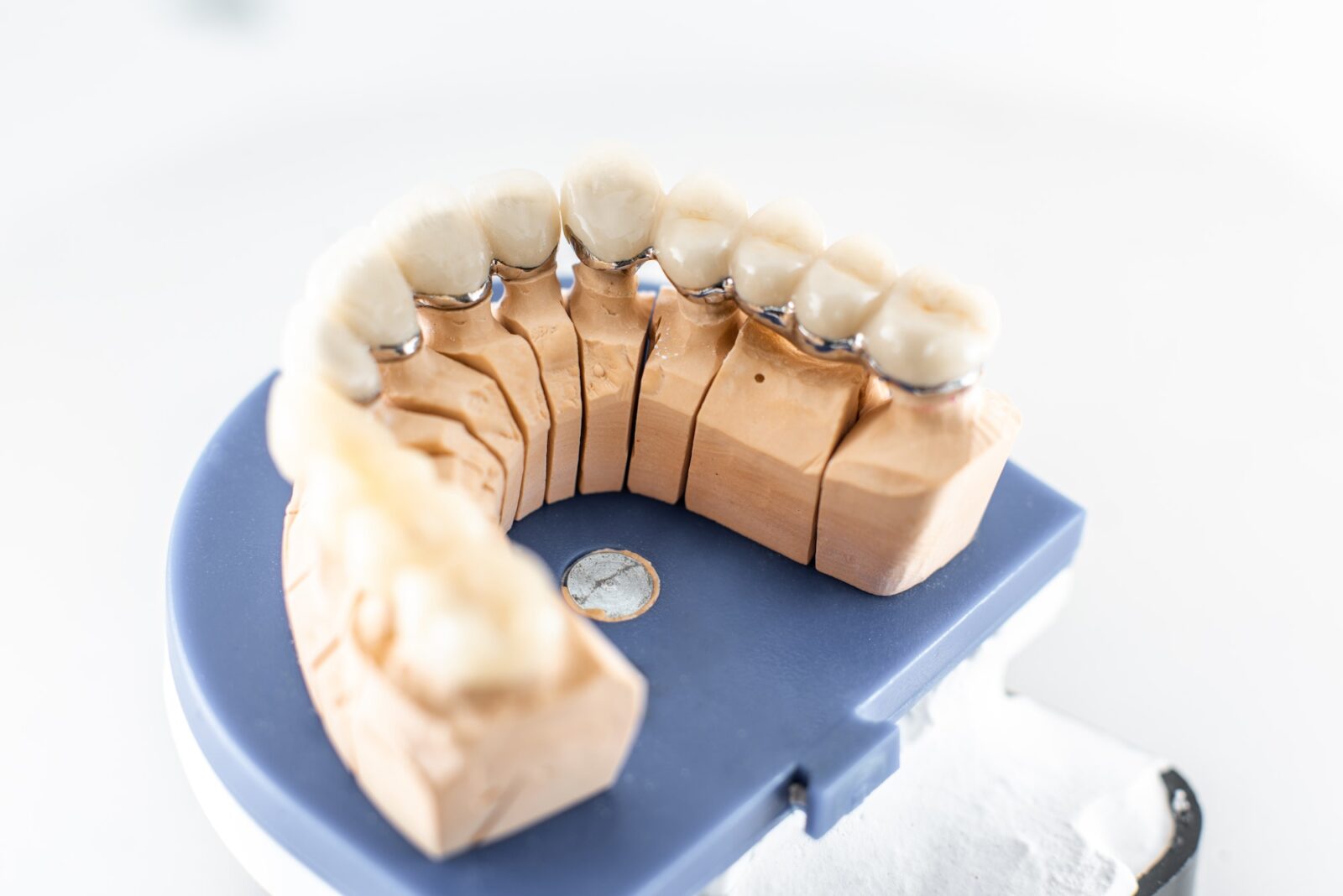
Whitening restorations, also known as whitening fillings, are dental restorations, such as fillings, crowns, or veneers, that are made to match the color of your teeth after they have been whitened. These restorations are used to replace or cover up existing restorations or natural teeth that are discolored or damaged and are designed to blend in with the rest of your teeth after they have been whitened.
Whitening restorations may be recommended if you have restorations or natural teeth that are significantly discolored or if you have other issues with your teeth, such as chips, cracks, or misalignment, that may be difficult to treat with teeth whitening alone. The process of getting whitening restorations typically involves a consultation with a dental professional, who will assess your oral health and determine the best approach to restoring your teeth. This may involve preparing your teeth for restoration, taking impressions or digital scans of your teeth, and creating the restoration in a dental laboratory. Once the restoration is complete, it will be fitted and bonded to your teeth to restore the appearance and function of your teeth.
| Method | Effectiveness | Speed | Longevity | Cost | Feedback |
|---|---|---|---|---|---|
| Bonding | High | Varies | Short | Moderate | Positive |
| Replacing Metal Fillings | High | Varies | Long | High | Positive |
| Veneers | High | Varies | Long | High | Positive |
| Crowns | High | Varies | Long | High | Positive |
| Implants | High | Varies | Long | High | Positive |
| Bridges | High | Varies | Long | High | Positive |
| Dentures | High | Varies | Long | High | Positive |
Bonding
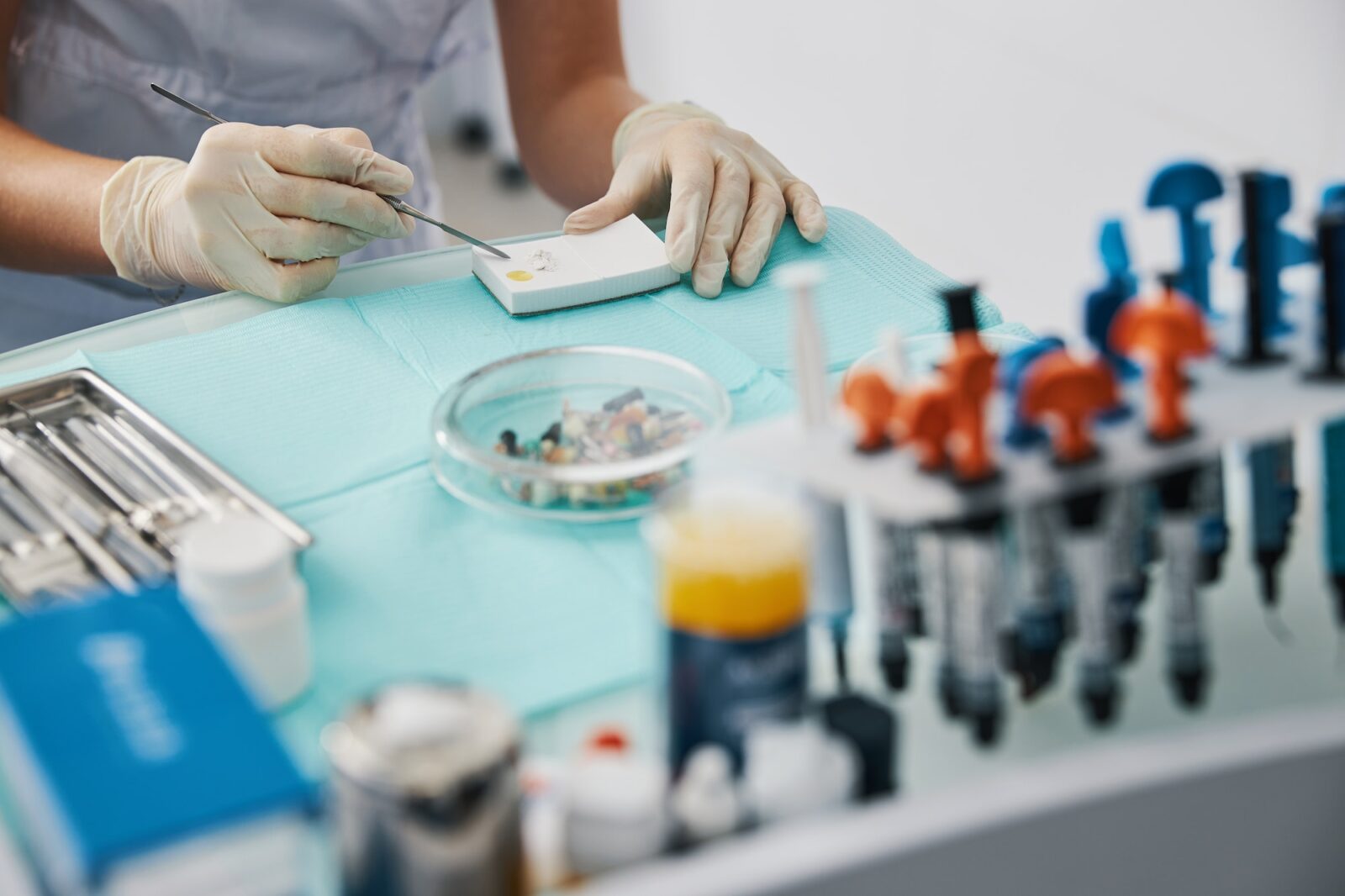
Method
Bonding is a type of tooth-colored resin material that is applied to the surface of the tooth and hardened with a special light. It is then shaped and polished to match the surrounding teeth.
Types
Bonding can be used to repair chips, cracks, and gaps in the teeth, as well as to change the shape or color of the teeth.
Brands
There are several brands of bonding material available, including Resin Plus, Surefil, and Sculpture.
Candidates
Bonding is typically suitable for people who have small to medium-sized chips, cracks, or gaps in their teeth, or who want to change the shape or color of their teeth. It is not suitable for people with large amounts of tooth decay or who need significant structural support for their teeth.
Results
Bonding can provide a natural-looking and long-lasting solution for minor tooth imperfections. However, the bonding material is not as strong as natural tooth enamel and may chip or wear down over time.
Risks
There is a risk of the bonding material staining or discoloring over time, and it may also shrink or pull away from the tooth surface.
Cost
Bonding is generally less expensive than other types of restorative treatments, such as veneers or crowns.
Feedback
Patients generally report satisfaction with the results of bonding, as it provides a quick and relatively affordable way to improve the appearance of their teeth.
Aftercare
It is important to practice good oral hygiene by brushing and flossing regularly and avoiding biting on hard foods or objects in order to maintain the longevity of the bonding material. It may also be necessary to have the bonding material touched up or replaced every few years.
Replacing Metal Fillings
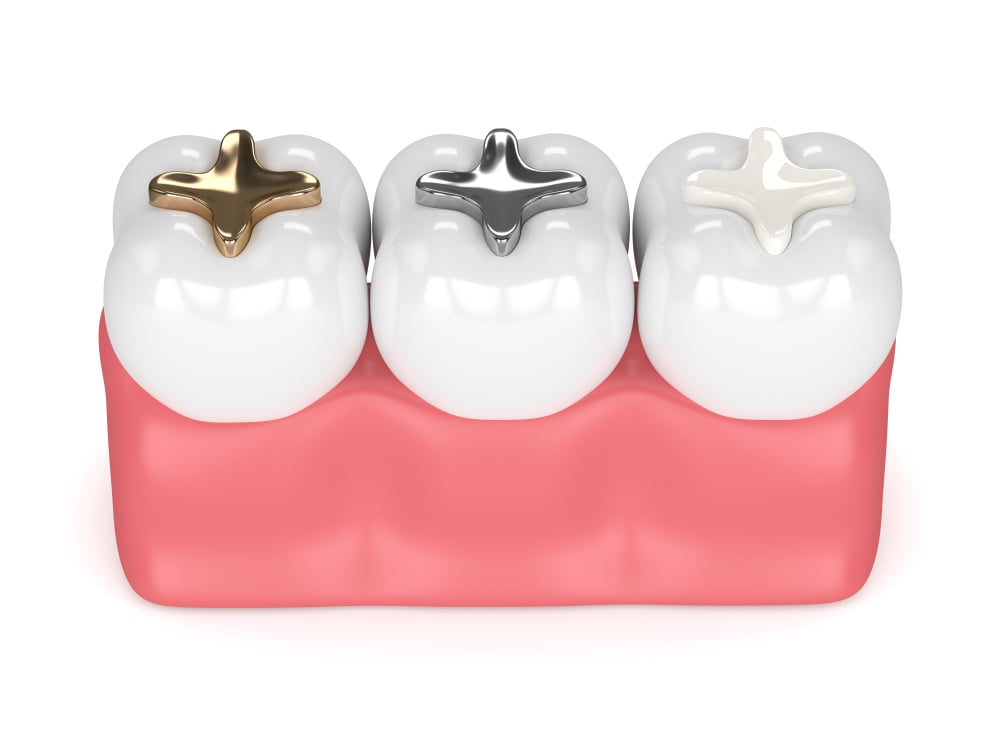
Method
Replacing metal fillings with tooth-colored fillings can help improve the appearance of the teeth. This is typically done by removing the old metal filling and replacing it with a new filling made of composite resin.
Types
There are various types of tooth-colored fillings available, including composite resin, porcelain, and glass ionomer.
Brands
Some common brands of tooth-colored fillings include 3M, Dentsply Sirona, and Kuraray.
Candidates
This type of restoration is suitable for individuals who have metal fillings that they would like to replace for cosmetic reasons.
Results
Replacing metal fillings with tooth-colored fillings can significantly improve the appearance of the teeth. The new fillings should blend in with the natural color of the teeth and be virtually indistinguishable from the rest of the tooth.
Risks
There are some risks associated with replacing metal fillings, including the possibility of tooth sensitivity, allergic reactions to the filling material, and the need for multiple visits to the dentist.
Cost
The cost of replacing metal fillings with tooth-colored fillings can vary depending on the location and type of filling used. It is generally more expensive than traditional metal fillings.
Feedback
Patients who have had metal fillings replaced with tooth-colored fillings generally report satisfaction with the results and an improved appearance of their teeth.
Aftercare
It is important to practice good oral hygiene after having metal fillings replaced, including brushing and flossing regularly and visiting the dentist for regular check-ups. It is also important to avoid biting hard or sticky foods, as these can damage the fillings.
Veneers

Method
Veneers are thin shells of porcelain or composite material that are custom-made to fit over the front surfaces of your teeth. They are typically used to correct cosmetic issues such as teeth that are chipped, crooked, discolored, or misshapen. To place veneers, your dentist will first prepare your teeth by removing a small amount of enamel from their fronts. This is done to ensure that the veneers fit properly and do not make your teeth look too bulky. Next, your dentist will take an impression of your teeth and send it to a dental laboratory, where your veneers will be fabricated. Once the veneers are ready, your dentist will bond them to your teeth using a special adhesive.
Types
There are two main types of veneers: porcelain and composite. Porcelain veneers are more durable and resistant to staining than composite veneers, but they are also more expensive. Composite veneers are made of a mixture of resin and fine glass particles, and they can be placed in a single appointment.
Brands
Some popular brands of veneers include Lumineers, Durathin, and EMAX.
Candidates
Veneers are a good option for people who have healthy teeth and gums and who want to improve the appearance of their smile. However, they are not suitable for people who have extensive tooth decay or gum disease, as these issues need to be addressed before veneers can be placed.
Results
Veneers can give you a brighter, more uniform smile that looks natural and attractive. They can also correct a number of cosmetic issues, such as gaps between teeth, uneven tooth lengths, and misshapen teeth.
Risks
Veneers are generally safe and have a high success rate. However, as with any dental procedure, there are some risks to consider. These may include sensitivity to hot and cold temperatures, gum irritation, and the possibility of veneers breaking or falling off.
Cost
The cost of veneers varies depending on the material used, the number of veneers needed, and the location of the dental practice. Porcelain veneers are typically more expensive than composite veneers. In the United States, the average cost of a single porcelain veneer ranges from $925 to $2,500, while the average cost of a single composite veneer ranges from $250 to $1,500.
Feedback
Most people are satisfied with the results of their veneers and report that they feel more confident about their smiles. However, some people may experience sensitivity or discomfort after the procedure, and it may take a few days for these symptoms to resolve.
Aftercare
To care for your veneers, brush and floss your teeth as you normally would and avoid biting into hard or sticky foods. You should also see your dentist for regular check-ups and cleanings to ensure that your veneers are in good condition.
Crowns

Method
Crowns are custom-made restorations that are cemented onto the top of a tooth to cover it entirely. They are often used to restore a tooth that is severely damaged or decayed.
Types
Crowns can be made of various materials such as porcelain, ceramic, resin, or gold.
Brands
There are many brands of crowns available, and your dentist will recommend the best option for you based on the location of the tooth and your specific needs.
Candidates
Crowns are usually recommended for people with damaged or decayed teeth that cannot be restored with other treatments such as fillings or veneers.
Results
Crowns can improve the appearance and function of a damaged tooth, and they can last for many years with proper care.
Risks
There is a small risk of tooth sensitivity or discomfort after the placement of a crown.
Cost
The cost of a crown can vary depending on the material used and the location of the tooth. Dental insurance may cover a portion of the cost.
Feedback
Most people are satisfied with the results of crown treatment, but it is important to discuss any concerns or questions with your dentist.
Aftercare
Proper oral hygiene, including brushing and flossing, is important to maintain the health of a crowned tooth. It is also important to see your dentist regularly for check-ups and cleanings.
Implants
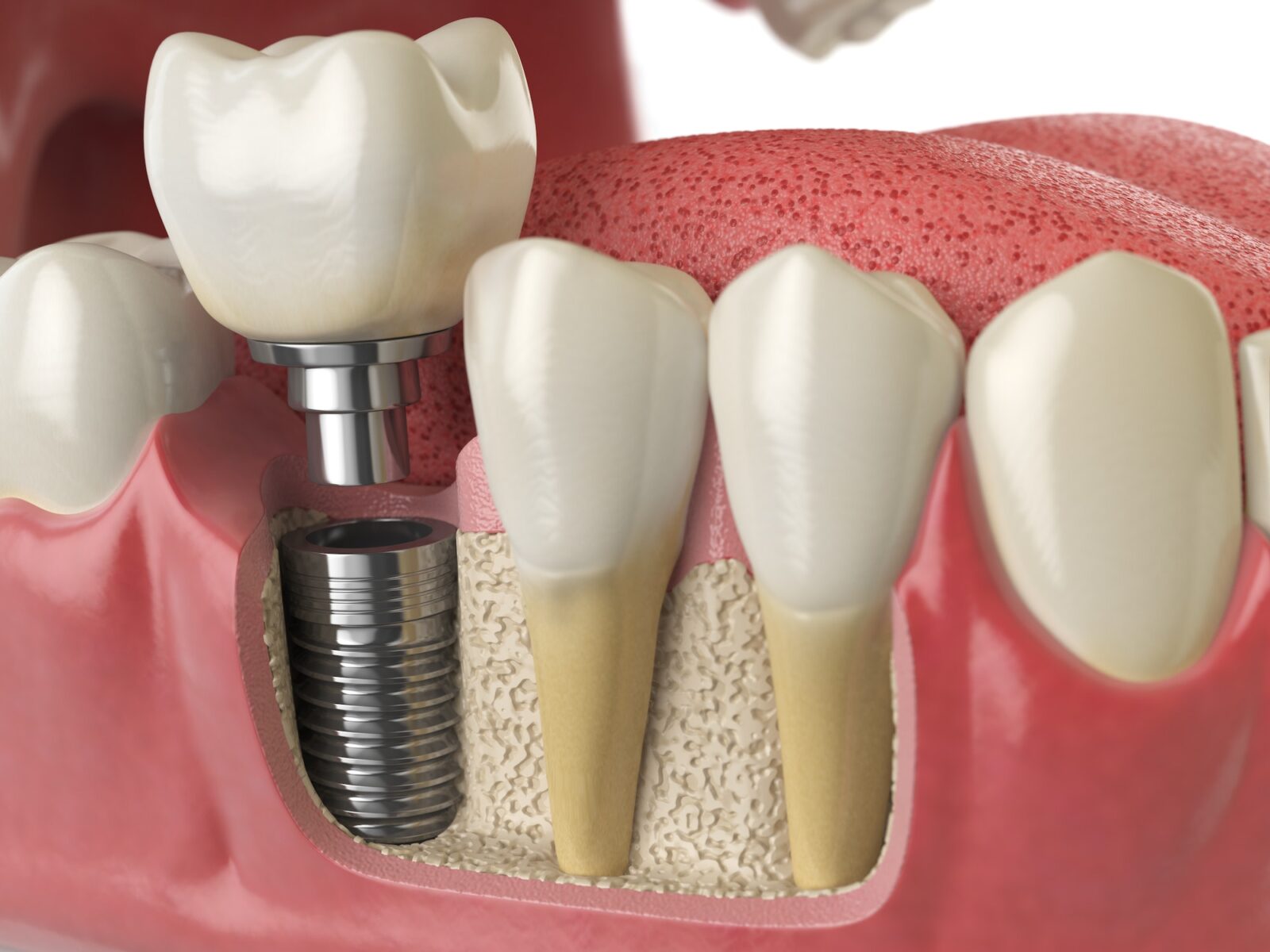
Method
Dental implants are a type of restoration for teeth that involve the insertion of a small titanium post into the jawbone to act as a replacement for the root of a missing tooth. The implant is then covered with a crown, which is a custom-made replacement tooth that is designed to match the color and shape of the surrounding natural teeth.
Types
There are several types of dental implants, including endosteal implants (which are placed directly into the jawbone), subperiosteal implants (which are placed on top of the jawbone), and mini implants (which are smaller and less invasive than traditional implants).
Brands
Some popular brands of dental implants include Straumann, BioHorizons, and Nobel Biocare.
Candidates
Dental implants are typically recommended for individuals who have lost a tooth or teeth due to trauma, decay, or periodontal disease. They may also be suitable for those who have a sufficient amount of healthy jawbone tissue to support the implant.
Results
Dental implants can provide a natural-looking and long-lasting solution for missing teeth. They can help to improve the appearance of the smile, as well as restore the ability to chew and speak properly.
Risks
Dental implants carry a risk of infection, nerve damage, and implant failure. However, these risks can be minimized with proper care and maintenance of the implants.
Cost
The cost of dental implants varies depending on the number of implants needed, the type of implant chosen, and the location of the practice. Insurance may cover some or all of the cost of the procedure.
Feedback
Many patients who have received dental implants are satisfied with the results, as they provide a natural-looking and functional replacement for missing teeth.
Aftercare
Proper oral hygiene, including brushing and flossing, is important to maintain the health of dental implants. Regular visits to the dentist for checkups and cleanings are also recommended to ensure the long-term success of the implants.
Bridges
Method
Bridges are a type of dental restoration that is used to replace missing teeth by attaching a false tooth to the natural teeth on either side of the gap.
Types
There are several different types of bridges, including traditional bridges, cantilever bridges, Maryland bridges, and implant-supported bridges.
Brands
There are many different brands of dental bridges available, including DenMat, Dental West, and Keystone Dental.
Candidates
Bridges may be a good option for people who have missing teeth and want to restore their smile and improve their ability to chew and speak. They may not be suitable for people with insufficient bone density or gum tissue to support the bridge.
Results
Bridges can be very effective at replacing missing teeth and improving the appearance of the smile. They may also help to prevent shifting of the teeth and changes in the bite.
Risks
There are some risks associated with bridges, including the potential for the bridge to come loose or fall out, gum irritation or infection, and tooth sensitivity.
Cost
The cost of a bridge can vary widely depending on the type of bridge, the materials used, and the location of the dental practice. In general, bridges tend to be more expensive than other types of dental restorations such as fillings or crowns.
Feedback
Most people are satisfied with the results of their dental bridges and report improved function and appearance of their teeth.
Aftercare
It is important to maintain proper oral hygiene and visit the dentist regularly to ensure the longevity of the bridge. This may include brushing and flossing around the bridge and attending regular cleanings and checkups.
Dentures
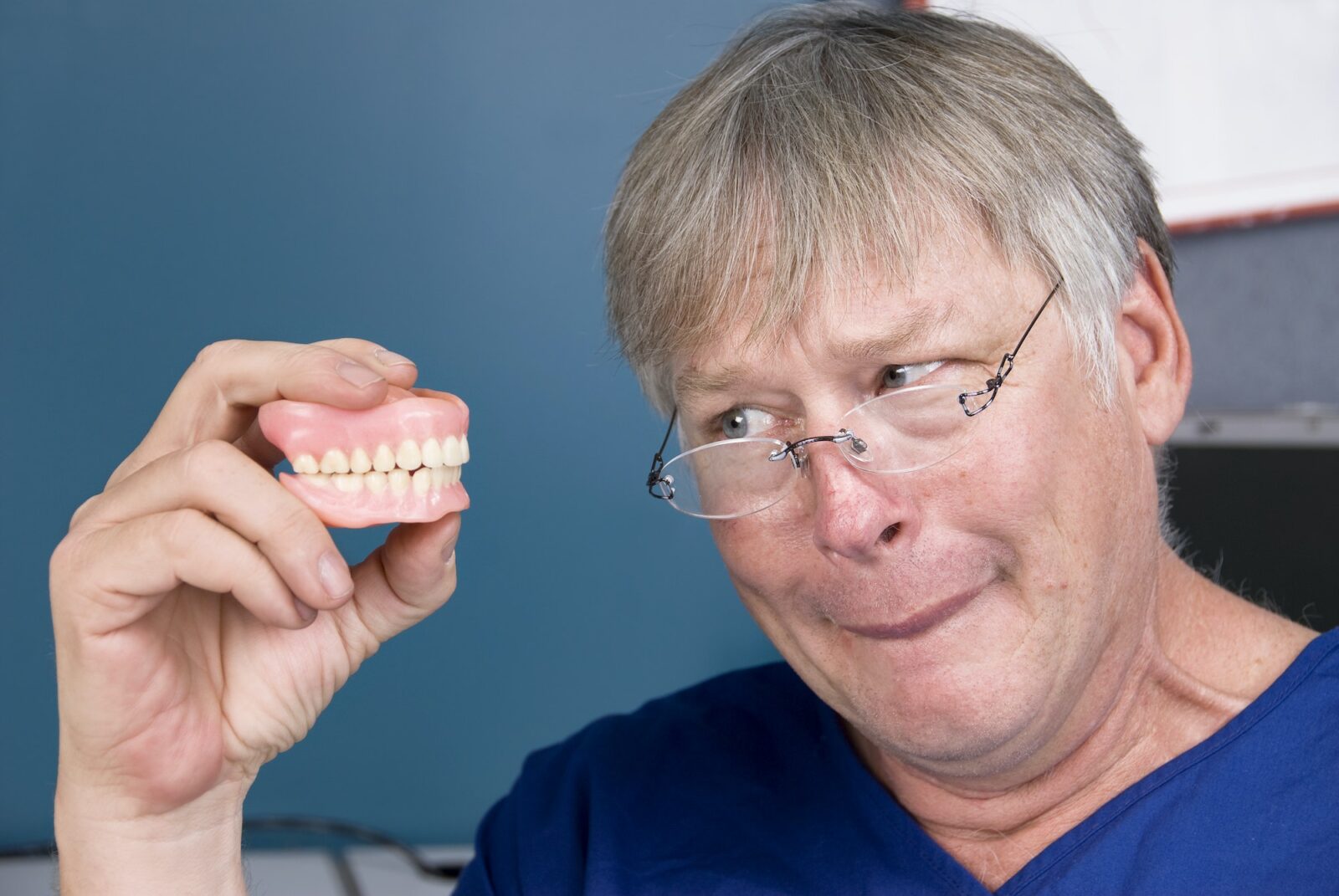
Method
Dentures are a type of restoration that is used to replace missing teeth. They are made of acrylic or porcelain and are custom-fit to the individual’s mouth.
Types
There are two main types of dentures: full dentures and partial dentures. Full dentures are used to replace all of the teeth in the upper or lower jaw, while partial dentures are used to replace just a few missing teeth.
Brands
Some popular brands of dentures include Aspen Dental, Affordable Dentures, and DenTech.
Candidates
Dentures are typically recommended for individuals who are missing most or all of their teeth and cannot tolerate other types of restorations, such as dental implants.
Results
Dentures can improve the appearance of a smile and help with speaking and eating. They may also help to support the facial muscles and prevent further bone loss in the jaw.
Risks
There is a risk of dentures becoming loose or falling out, as well as the risk of allergic reactions to the materials used to make them. It is important to follow the care instructions provided by the dentist to minimize these risks.
Cost
The cost of dentures varies based on the type of dentures and the material used. Insurance may cover some of the cost.
Feedback
Most people are satisfied with the results of their dentures, but it may take some time to get used to them and make any necessary adjustments.
Aftercare
It is important to brush and soak dentures daily to keep them clean and to prevent bad breath. It is also important to see a dentist regularly to check the fit and condition of the dentures.
What should I consider when making the decision to whiten my teeth?
Oral Health
It is important to consider your oral health when deciding which teeth whitening treatment to pursue. If you have untreated cavities, gum disease, or other oral health issues, it is generally recommended to address them before starting a teeth whitening treatment.
Causes of Discoloration
It is also important to consider the cause of the discoloration of your teeth when deciding which teeth whitening treatment to pursue. Some types of stains and discoloration, such as those caused by medications or fluorosis, may be more difficult to treat with teeth whitening and may require alternative treatment options.
Sensitivity
If you have sensitive teeth or gums, it is important to consider whether a teeth whitening treatment is appropriate for you. Some teeth whitening methods and products can cause sensitivity and may not be suitable for individuals with sensitive teeth or gums.
Timing
If you are planning to whiten your teeth for a specific event, such as a wedding or a job interview, it is important to consider the timing of the treatment to ensure that you have enough time for the treatment to take effect and for any potential side effects to resolve.
Age
- Children and adolescents may not be suitable candidates for teeth whitening due to the potential risks of using certain products or methods.
- Teens may be able to use low-intensity teeth whitening treatments, such as toothpaste or strips, but it is important to consult with a dental professional before starting any treatment.
- Most young adults and adults can handle a wider range of teeth whitening treatments, but it is important to consider the potential risks and benefits of different treatments and to choose a method and product that is suitable for your needs.
- Elderly individuals may need to consider restorative solutions, such as veneers, if they have other issues with their teeth, such as chips, cracks, or misalignment.
ADA Recommendation
The American Dental Association (ADA) recommends that individuals considering teeth whitening consult with a dental professional to determine the best approach to maintaining the health and appearance of their teeth and to determine whether teeth whitening is appropriate for their needs. When choosing a teeth whitening product or service, the ADA recommends that individuals look for products that have been granted the ADA’s Seal of Acceptance for safety and effectiveness. In addition, the ADA recommends that individuals follow the manufacturer’s instructions for use when using a teeth whitening product and consult with a dental professional if they experience any adverse effects. The ADA also recommends that individuals maintain good oral hygiene and visit a dental professional regularly to help prevent tooth discoloration and to maintain the results of a teeth whitening treatment.
How do I find the most cost-effective method to whiten my teeth?
Method
Finding the most cost-effective method to whiten your teeth will depend on your specific needs and preferences. Here are some things to consider when trying to find the most cost-effective method for you:
- Oral hygiene: Maintaining good oral hygiene is the most cost-effective way to keep your teeth white. Regular brushing, flossing, and dental check-ups can prevent plaque and tartar buildup, which can cause discoloration.
- Home remedies: Using home remedies such as baking soda or charcoal can be a cost-effective way to whiten your teeth. These methods are relatively inexpensive and can be effective in removing surface stains. However, they may not be as effective as professional treatments and can cause tooth sensitivity if used incorrectly.
- Over-the-counter products: There are many over-the-counter products such as whitening toothpastes, gels, and strips that can be purchased at a drugstore. These products can be less expensive than other methods, but they may not be as effective and may cause tooth sensitivity.
- Take-home kits: At-home whitening kits can be more cost-effective than in-office treatments. They typically include custom-made trays and a bleaching gel that can be used at home.
- In-office professional treatments: In-office professional treatments can be more expensive than other methods, but they can provide faster and more dramatic results. If you’re looking for a fast, effective solution, in-office professional treatments may be the best option for you.
- Whitening restorations: This method can be more effective in restoring a natural-looking, white smile, but it is also more expensive and may require multiple dental visits. It’s best to have a consultation with your dentist to know if this method is suitable for you and if it’s cost-effective.
It’s important to consult your dentist to determine which method is best for you and your budget. They can help you understand the pros and cons of each method and recommend the most cost-effective solution for your individual needs.
Insurance
Insurance coverage for teeth whitening may vary depending on your insurance plan and the treatment you are considering. Some insurance plans may cover a portion of the cost of teeth whitening if it is deemed medically necessary, such as if the discoloration is caused by a medical condition or by certain medications. However, most insurance plans do not cover cosmetic teeth whitening costs.
Saving
To save on the cost of teeth whitening, you may want to consider:
- Comparing prices: It is a good idea to shop around and compare prices for different teeth whitening methods and products to find the most cost-effective option for your needs.
- Using coupons or discounts: Many dental offices and online retailers offer coupons or discounts on teeth whitening products and services.
- Asking about financing options: Some dental offices offer financing options or payment plans to help make teeth whitening more affordable.
- Considering the long-term cost: It is important to consider the long-term cost of teeth whitening, including the need for touch-up treatments or maintenance to maintain the results. In some cases, treatments that produce more modest but longer-lasting results may be more cost-effective in the long run than treatments that produce more dramatic but shorter-lasting results.
How do I find the best dentist for teeth whitening?

Experience
Experience is an important factor to consider when selecting a dentist for teeth whitening. Look for a dentist who is accredited by a professional organization such as the American Dental Association (ADA). This can ensure that the dentist has received proper training and education. You may also want to ask to see before-and-after photos or other examples of their work.
Location
Consider the location of the dentist’s office and whether it is convenient for you to visit.
Comfort
Make sure you feel comfortable with the dentist and their staff. You should feel at ease asking questions and discussing your concerns.
Reviews
Reading reviews and ratings from past patients can be helpful in determining the quality of a dental practice. Look for a practice with a good reputation and positive patient reviews.
Expectations
It is important to have realistic expectations about the results of teeth whitening treatment. You should ask the dentist to provide a written treatment plan outlining the expected results and any associated risks or limitations. You should also ask about the steps the dentist will take to ensure that your expectations are realistic and that you are satisfied with the treatment results.
Find the top cosmetic dentist in your area in our rankings.
What are some common scams involving teeth whitening?
Low-Quality Materials
Some individuals or companies may try to sell cheap, low-quality products that do not contain the proper concentrations of teeth-whitening agents. These products may not produce the desired results and can even harm teeth and gums. It is important to use products that are approved by the American Dental Association (ADA) and the Food and Drug Administration (FDA) to ensure safety and effectiveness.
Unlicensed Practitioners
Some individuals may offer teeth whitening services without the proper training or regulation. These individuals may not follow proper protocols for sterilization and may use dangerous or ineffective products. It is important to only receive teeth whitening treatments from trained and licensed professionals.
Misleading Advertisements
Some companies may make false or exaggerated claims about the results of their teeth-whitening products. Doing thorough research and consulting with a dental professional before purchasing any products or services is important.
Overpriced Treatments
Some teeth whitening treatments can be quite expensive, especially if a celebrity or high-end spa offers them. However, it is important to remember that the price of treatment does not necessarily reflect its effectiveness. In some cases, more affordable options may be just as effective. Shopping around and comparing prices before committing to treatment is always a good idea.
What are some common mistakes involving teeth whitening?
Not Seeking Professional Advice
Many people try to whiten their teeth at home without consulting a professional first. This can be dangerous as not all teeth are suitable for whitening, and some people may have underlying oral health issues that need to be addressed before attempting to whiten their teeth. Before starting any teeth whitening treatment, it is always best to speak with a dentist or dental hygienist.
Using the Wrong Products
Many teeth whitening products are available, and it can be difficult to know which one is best for you. Some products contain harsh chemicals that can damage your teeth and gums, while others may not be effective at all. It is important to do your research and choose a reputable brand that has been recommended by a dental professional.
Overdoing It
It is possible to have too much of a good thing when it comes to teeth whitening. Using whitening products too frequently or too long can lead to sensitivity and even damage your teeth. It is important to follow the product instructions carefully and stop using them if you experience discomfort.
Not Maintaining Oral Hygiene
Whitening your teeth is only one part of maintaining a healthy smile. It is important to continue to brush and floss regularly and to see a dental professional for regular check-ups and cleanings. Neglecting your oral hygiene can negate the effects of teeth whitening and even lead to further staining and decay.
Falling for Scams
There are many scams and false claims in the teeth whitening industry. It is important to do your research and only use reputable products and treatments.
What are some tips for safe teeth whitening?

Consult with a Dental Professional
It is always best to consult with a dental professional before starting any teeth whitening treatment. A dental professional can evaluate your oral health and determine the best teeth whitening method for your needs. They can also advise you on the potential risks and benefits of different teeth whitening treatments and help you to minimize the risk of adverse effects.
Follow the Instructions Provided
It is important to follow the instructions provided with any teeth whitening product or treatment to ensure that it is used safely and effectively. This includes following the recommended frequency and duration of use and using the product according to the manufacturer’s instructions.
Use a Reputable Product or Treatment
It is important to use a reputable teeth whitening product or treatment that has been tested for safety and effectiveness. This can help minimize the risk of adverse effects and ensure you get the best results possible.
Avoid Overuse
It is generally not recommended to use teeth whitening products or treatments more frequently or for longer periods of time than recommended. Overusing teeth whitening products can cause sensitivity and irritation and may not produce any additional whitening effect.
Wear a Lip Balm
It is generally recommended to wear a lip balm during teeth whitening treatment to protect the lips and gums from the bleaching agents used in the treatment.
Avoid the Use of Abrasive Toothpaste
It is generally not recommended to use abrasive toothpaste during or after teeth whitening treatment, as the abrasives in the toothpaste can potentially damage the enamel or the gums.
What is the proper aftercare for my teeth whitening treatment?
Avoid Stain-Causing Substances
One of the most important aspects of aftercare for teeth whitening is to avoid substances that can cause staining. This includes foods and drinks such as berries, soy sauce, and balsamic vinegar. Additionally, using a straw when drinking stain-causing beverages can help minimize contact with your teeth.
Maintain Oral Hygiene
- Brush and floss regularly: Proper oral hygiene is crucial for maintaining your teeth whitening treatment results. Brush your teeth twice a day with whitening toothpaste, and floss daily to remove any plaque or debris between your teeth.
- Use mouthwash: Mouthwash can help kill bacteria and freshen your breath, which can help maintain the brightness of your teeth.
Touch-Up Treatments
Several options are available for touch-up treatments, including at-home kits and professional treatments. At-home kits, such as whitening strips or gels, can be used on a regular basis to maintain the results of your treatment. Professional treatments, such as in-office laser whitening or take-home kits provided by your dentist, can also be used to touch up the results of your treatment. Following the recommended frequency and usage instructions for any touch-up treatment is important to ensure the best results and minimize tooth sensitivity risk. Touch-up treatments may not be necessary for everyone, as the longevity of teeth whitening results can vary based on factors such as diet, oral hygiene habits, and the type of treatment received.
Manage Sensitivity
It’s common for teeth to be sensitive to hot, sweet, and cold foods and drinks for a few days after whitening. You can try using toothpaste for sensitive teeth, which can help to reduce the sensitivity. If the sensitivity persists or becomes severe, it’s important to contact your dentist for further evaluation and treatment. Sometimes, your dentist may recommend using a different whitening product or suggest you wait longer between touch-up treatments
FAQ
Does teeth whitening damage the nerve of the tooth?
Teeth whitening is generally safe and does not typically cause damage to the nerve of the tooth. However, it is possible for teeth whitening to cause sensitivity or discomfort, especially if it is done incorrectly or if the person has sensitive teeth.
To minimize the risk of sensitivity or discomfort, it is important to follow the manufacturer’s instructions for use when using a teeth whitening product and to consult with a dental professional if you experience any adverse effects. If you have sensitive teeth, you may want to consider using a teeth whitening product that is formulated for sensitive teeth or to use a lower concentration of the whitening agent. You may also want to consider using a desensitizing toothpaste before and after whitening to help reduce sensitivity.
If you experience severe pain or sensitivity during or after teeth whitening, you should consult with a dental professional as soon as possible. It is important to seek dental care if you experience any unusual symptoms, as these may be signs of an underlying dental issue that needs to be addressed.
Does teeth whitening damage existing restorations?
Teeth whitening may not damage existing restorations, but it is possible for the color of the restoration to become mismatched with the color of the surrounding teeth after the teeth have been whitened. This can be especially noticeable if the restoration is made from a material that does not respond well to teeth whitenings, such as amalgam or metal.
If you have existing restorations and are considering teeth whitening, it is important to consult with a dental professional to determine the best approach to maintaining the health and appearance of your teeth and to determine whether teeth whitening is appropriate for your needs. The dental professional may recommend that you wait to whiten your teeth until the restorations can be replaced or that you use a lower concentration of the whitening agent to minimize the risk of color mismatch.
In some cases, it may be possible to have the restoration replaced or refinished after the teeth have been whitened to match the color of the surrounding teeth. This can be especially useful if you have a porcelain or composite resin restoration, which can be matched to the color of your teeth more closely than other materials.
Does teeth whitening make teeth more brittle?
Teeth whitening is not known to make teeth more brittle. In fact, teeth whitening is generally considered a safe and effective way to improve the appearance of your teeth.
That being said, it is possible that teeth whitening may cause temporary sensitivity or discomfort in some people. This is usually due to the peroxide-based whitening agents that are used to bleach the teeth. Sensitivity is usually temporary and can be managed with over-the-counter pain relievers or by using toothpaste formulated for sensitive teeth.
If you experience persistent sensitivity or other side effects after teeth whitening, you should contact a dental professional for further evaluation and guidance.
How long does teeth whitening last?
The duration of teeth whitening results can vary depending on the method and product used, as well as on your oral hygiene habits and your diet. Some common factors that can affect the duration of teeth whitening results include:
- The type of whitening method: Some methods, such as professional in-office treatments, tend to produce longer-lasting results than others, such as over-the-counter products.
- The type of whitening product: Some products, such as bleaching trays and gels, may produce longer-lasting results than others, such as strips or toothpaste.
- Your oral hygiene habits: Good oral hygiene habits, such as brushing and flossing regularly and using fluoride toothpaste, can help to maintain the results of teeth whitening and prevent new stains from forming.
- Your diet: Consuming foods and drinks that can stain your teeth, such as coffee, tea, red wine, and tobacco, can cause the results of teeth whitening to fade more quickly.
In general, teeth whitening results can last for several months to a year, depending on the factors listed above. To maintain the results of teeth whitening, it is important to follow the manufacturer’s instructions for use and to practice good oral hygiene habits. You may also want to consider using touch-up products, such as whitening toothpaste or whitening strips, to help maintain the results of teeth whitening and to prevent new stains from forming.
Does going abroad for teeth whitening make sense?
It is generally not a good idea to go abroad for teeth whitening for several reasons. First and foremost, it is important to ensure that you are receiving dental care from a qualified and licensed dental professional. Going abroad for teeth whitening may put you at risk of receiving treatment from an unqualified or unlicensed individual, which could result in poor treatment quality or even harm to your oral health.
In addition, it is important to consider the potential risks and complications of teeth whitening, including sensitivity, discomfort, and damage to the teeth or gums. Receiving treatment from a qualified and licensed dental professional who is familiar with your medical history and oral health can help to minimize these risks and to ensure that you receive the best possible care.
Finally, it is important to consider the cost of going abroad for teeth whitening, including the cost of travel, accommodation, and treatment. In many cases, it may be more cost-effective to receive treatment from a dental professional in your own country.
Overall, it is generally not a good idea to go abroad for teeth whitening. It is always best to consult with a qualified and licensed dental professional in your own country to determine the best approach to maintaining the health and appearance of your teeth and to determine whether teeth whitening is appropriate for your needs.
What is the list of foods to avoid after whitening my teeth?
After teeth whitening, it is generally recommended to avoid consuming foods and drinks that can stain your teeth for at least the first 48 hours. Some common foods and drinks to avoid include:
- Coffee, tea, and other dark beverages
- Red wine and other alcoholic beverages
- Darkly colored fruits, such as berries and pomegranates
- Tomato-based products, such as pasta sauce and ketchup
- Soy sauce and other darkly colored condiments
- Beets and other brightly colored vegetables
- Chocolate and other sweets
- Tobacco products
It is also a good idea to brush your teeth or rinse your mouth with water after consuming these types of foods and drinks to help remove any residue that may be left on your teeth.
In general, it is important to practice good oral hygiene habits, including brushing and flossing regularly and using fluoride toothpaste, to help maintain the results of teeth whitening and to prevent new stains from forming. You may also want to consider using touch-up products, such as whitening toothpaste or whitening strips, to help maintain the results of teeth whitening and to prevent new stains from forming.
What is the safest method for teeth whitening?
There are several methods for whitening teeth, and the safety of each method can vary. In general, professional teeth whitening performed by a dentist is considered to be the safest and most effective method. This is because the dentist can carefully monitor the process and use a higher concentration of bleaching agent than is allowed in over-the-counter products, resulting in better and more consistent results. At-home kits that use lower concentrations of bleaching agents and provide instructions for proper use can also be safe if used as directed. It is important to follow the instructions for any teeth whitening product to avoid causing harm to the teeth or gums. If you have any concerns about the safety of a particular product or method, you should consult your dentist.
Why didn’t teeth whitening work for me?
There are several reasons why teeth whitening may not have produced the desired results for you. Some common reasons include:
- Your teeth are naturally discolored: If your teeth are naturally discolored due to factors such as genetics or the use of certain medications, teeth whitening may not be effective at removing the discoloration.
- Your teeth are damaged: If your teeth are damaged or have been restored with materials such as fillings, crowns, or veneers, teeth whitening may not be effective at improving the appearance of these teeth.
- You have dental issues: If you have dental issues such as cavities or gum disease, teeth whitening may not be effective until these issues are addressed.
- You did not follow the instructions for use: If you did not follow the instructions for use for the teeth whitening product, it may not have produced the desired results.
- You have unrealistic expectations: It is important to have realistic expectations when it comes to teeth whitening. While teeth whitening can improve the appearance of your teeth, it may not be able to produce dramatic changes in the color of your teeth.
If you are not satisfied with the results of teeth whitening, it is a good idea to consult with a dental professional to determine the best approach to maintaining the health and appearance of your teeth and to determine whether other treatments, such as veneers or bonding, may be more appropriate for your needs.
Why does teeth whitening hurt?
Some people may experience sensitivity or discomfort when using teeth whitening products. This can occur because the bleaching agents used in these products can cause irritation of the gums and mouth, or because the process of bleaching the teeth can cause the teeth to become dehydrated and more susceptible to sensitivity.
If you experience sensitivity or discomfort while using a teeth whitening product, you may be able to reduce these symptoms by:
- Using a product with a lower concentration of bleaching agents
- Using the product for a shorter period of time
- Brushing your teeth with toothpaste for sensitive teeth before using the whitening product
- Rinsing your mouth with a fluoride mouthwash after using the whitening product
If the sensitivity or discomfort persists or is severe, you should stop using the whitening product and consult with a dental professional. They can help determine the cause of the sensitivity and recommend the appropriate treatment.
Will teeth whitening work on fillings?
Teeth whitening may not be effective at improving the appearance of teeth that have been restored with materials such as fillings, crowns, or veneers. This is because these restorations are not affected by the teeth whitening process and will remain the same color as before treatment.
If you are unhappy with the appearance of your fillings, crowns, or veneers, it is a good idea to consult with a dental professional to discuss your options. In some cases, it may be possible to replace these restorations with ones that are a better match for your natural tooth color.
Which teeth whitening method works best?
There are several different teeth whitening methods available, and the best method for you will depend on your specific needs and preferences. Some common teeth whitening methods include:
Oral hygiene is considered the most cost-effective way to maintain a white smile, by keeping your teeth and gums clean can help prevent surface stains and discoloration caused by plaque and tartar buildup.
Home remedies such as baking soda or charcoal can be an inexpensive way to whiten teeth, but they may not be as effective as professional treatments and can cause tooth sensitivity if used incorrectly.
Over-the-counter products, such as whitening toothpastes, gels, and strips, can be less expensive than other methods, but they may not be as effective and may cause tooth sensitivity.
Take-home kits, prescribed by a dental professional, can be more cost-effective than in-office treatments. They typically include custom-made trays and a bleaching gel that can be used at home.
In-office professional treatments, also known as power whitening, use a high-intensity light or laser to activate a bleaching gel and whiten the teeth. This method can provide fast and dramatic results and can whiten teeth several shades in just one visit. It’s typically done by a dental professional and can be customized to the individual’s needs.
Whitening restorations involve replacing existing dental restorations such as crowns, veneers, or fillings with new, whitened versions. This can include replacing old metal fillings with tooth-colored composite fillings or replacing old crowns or veneers with new, whitened versions. This method can be more effective in restoring a natural-looking, white smile, but it is also more expensive and may require multiple dental visits.
In general, professional in-office treatments tend to produce the fastest and most dramatic results, but they may be more expensive and less convenient than other methods. At-home treatments and over-the-counter products may be more affordable and convenient, but they may take longer to produce results and may be less effective.
Are there any products in take-home kits that I cannot get over the counter?
In general, the active ingredients in take-home teeth whitening kits are available over the counter. However, some products may require a prescription from a dental professional. For example, higher concentrations of hydrogen peroxide or carbamide peroxide (the active ingredients in most teeth whitening products) may require a prescription. Additionally, some take-home teeth whitening kits may be available only through a dental professional, as they may contain custom-fit trays or other specialized components.
Are teeth whitening strips safe?
Teeth whitening strips are generally considered safe when used as directed. However, some people may experience mild side effects such as sensitivity or irritation of the gums or mouth. It is important to follow the instructions provided with the teeth whitening strips and to consult with a dental professional if you have any concerns. It is also a good idea to avoid using teeth whitening products too frequently, as overuse can lead to sensitivity and other side effects.
Can teeth whitening cause permanent sensitivity?
Teeth whitening can cause temporary sensitivity, but it is generally not permanent. The sensitivity is usually due to the bleach used in the whitening process. This sensitivity should go away a few days after the whitening treatment. If the sensitivity persists or is severe, you should contact your dental professional. It is important to follow the instructions provided by your dental professional or the manufacturer of the whitening product to minimize the risk of sensitivity.
Does teeth whitening work on dead teeth?
Teeth whitening is not effective on dead teeth because the bleach used in the whitening process only works on living tissue. Dead teeth, also known as non-vital teeth, do not have a blood supply and are not responsive to treatment. If you have a dead tooth that is causing problems, your dental professional will recommend treatment options that are appropriate for your situation. These may include removing the dead tooth, root canal therapy to remove the infected tissue and preserve the tooth, or extraction and replacement with an artificial tooth.
Can teeth whitening damage the gums?
Teeth whitening products can potentially cause irritation or damage to the gums if the bleach comes into contact with the gums. To minimize the risk of gum irritation or damage, it is important to follow the instructions provided by your dental professional or the manufacturer of the whitening product. If you experience gum irritation or other problems during or after a teeth whitening treatment, you should contact your dental professional for advice.
It is also important to choose a reputable brand of teeth whitening product and to follow the instructions carefully. Some products can be more harsh or irritating than others. Using a product that is too strong or using it for too long can increase the risk of gum irritation or damage
Resources
Study Shows Many People Hate Smiling. (June 2015). Dentistry Today.
Tooth Whitening in the Orthodontic Practice: A Survey of Orthodontists. (April 2013). American Journal of Orthodontics and Dentofacial Orthopedics.
U.S. Population: Usage of Tooth Whiteners From 2011 to 2024. (July 2021). Statista.
Whitening Toothpaste Containing Activated Charcoal, Blue Covarine, Hydrogen Peroxide or Microbeads: Which One Is the Most Effective? (January 2019). Journal of Applied Oral Science (JAOS).
Over-the-Counter Tooth Whitening Agents: A Review of Literature. (June 2020). Brazilian Dental Journal.
Accepted Products. American Dental Association (ADA).
Efficacy of Mouthwashes Containing Hydrogen Peroxide on Tooth Whitening. (July 2015). The Scientific World Journal.
The Win-Win of Whitening Pens: Whitening Pens Tap Into a Market That’s Crazy for a Nicer Smile. (December 2016). RDH.
Tray Bleaching Status and Insights. (December 2020). Journal of Esthetic and Restorative Dentistry.
A Clinical Study of the Effectiveness of a Light Emitting Diode System on Tooth Bleaching. (September 2012). The Open Dentistry Journal.
The Effect of Light-Activation Sources on Tooth Bleaching. (September-October 2014). Nigerian Medical Journal.
Professional Teeth Whitening: Everything You Need to Know. (June 2021). Forbes Health.
Effectiveness and Adverse Effects of Over-the-Counter Whitening Products on Dental Tissues. (June 2021). Frontiers in Dental Medicine.
Whitening. (October 2020). American Dental Association (ADA).
BDJ Study on Dangers of Teeth Whitening Products Provokes Significant Media Interest. (April 2019). BDJ Team.
Oral-B 3D White Luxe Perfection Toothpaste. (2021). Procter & Gamble.
Crest 3D Whitestrips Professional Effects Teeth Whitening Strips. (2021). Procter & Gamble.
Crest 3D White Glamorous White Multi-Care Whitening Mouthwash. (2021). Procter & Gamble.
Oral Care Starts Here. (2021). Auraglow.
Opalescence. Opalescence.
Teeth Whitening Kit- 3D Pro Advanced. (2021). GlossRay.



